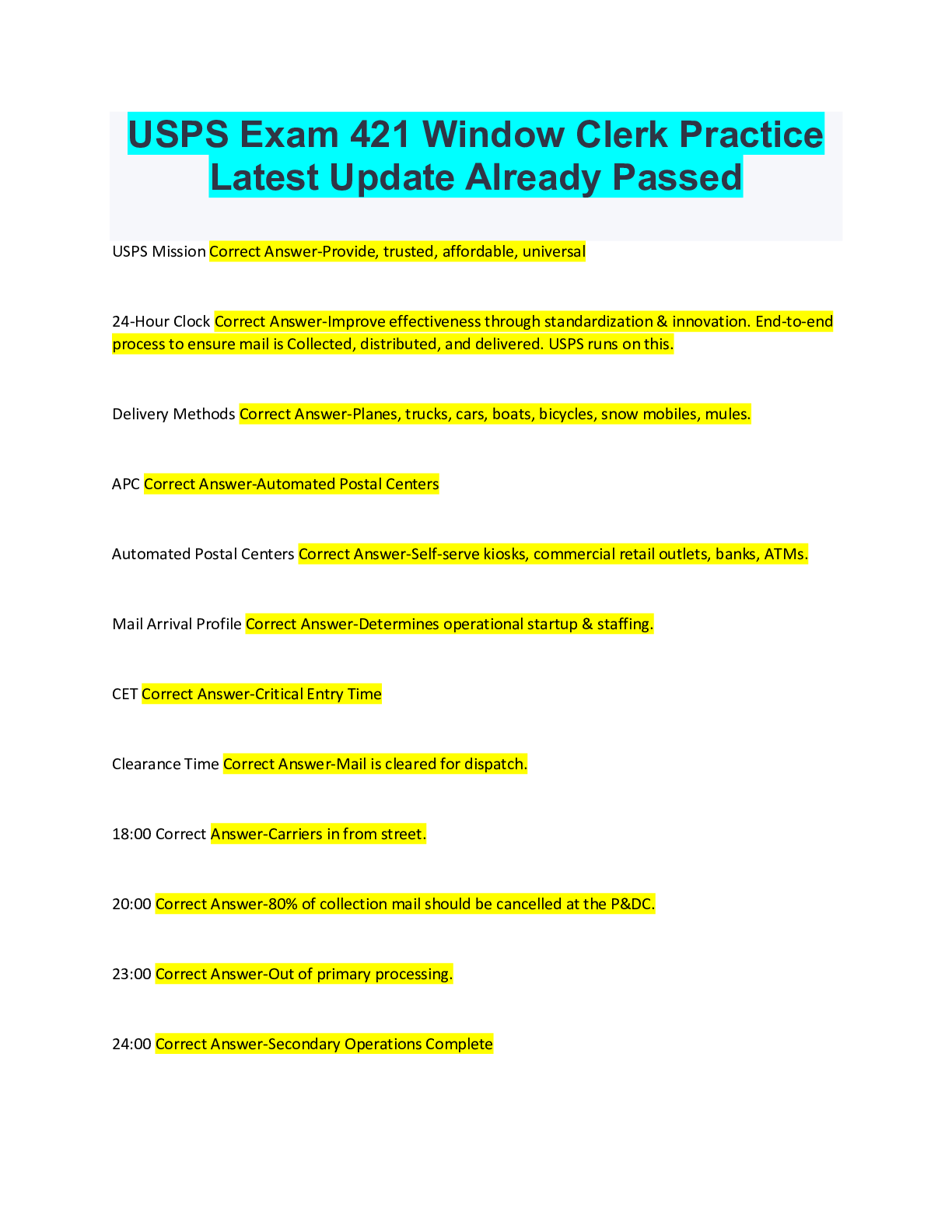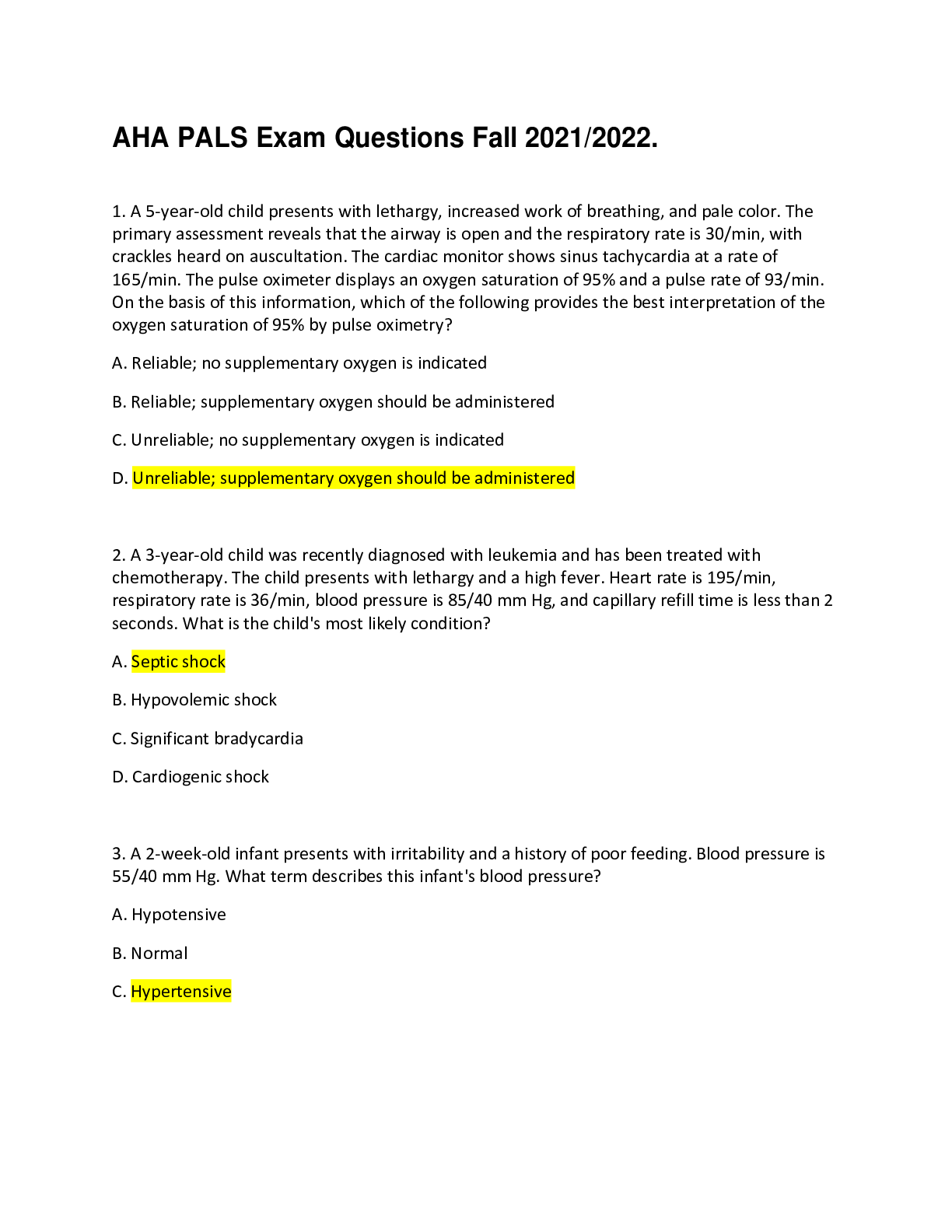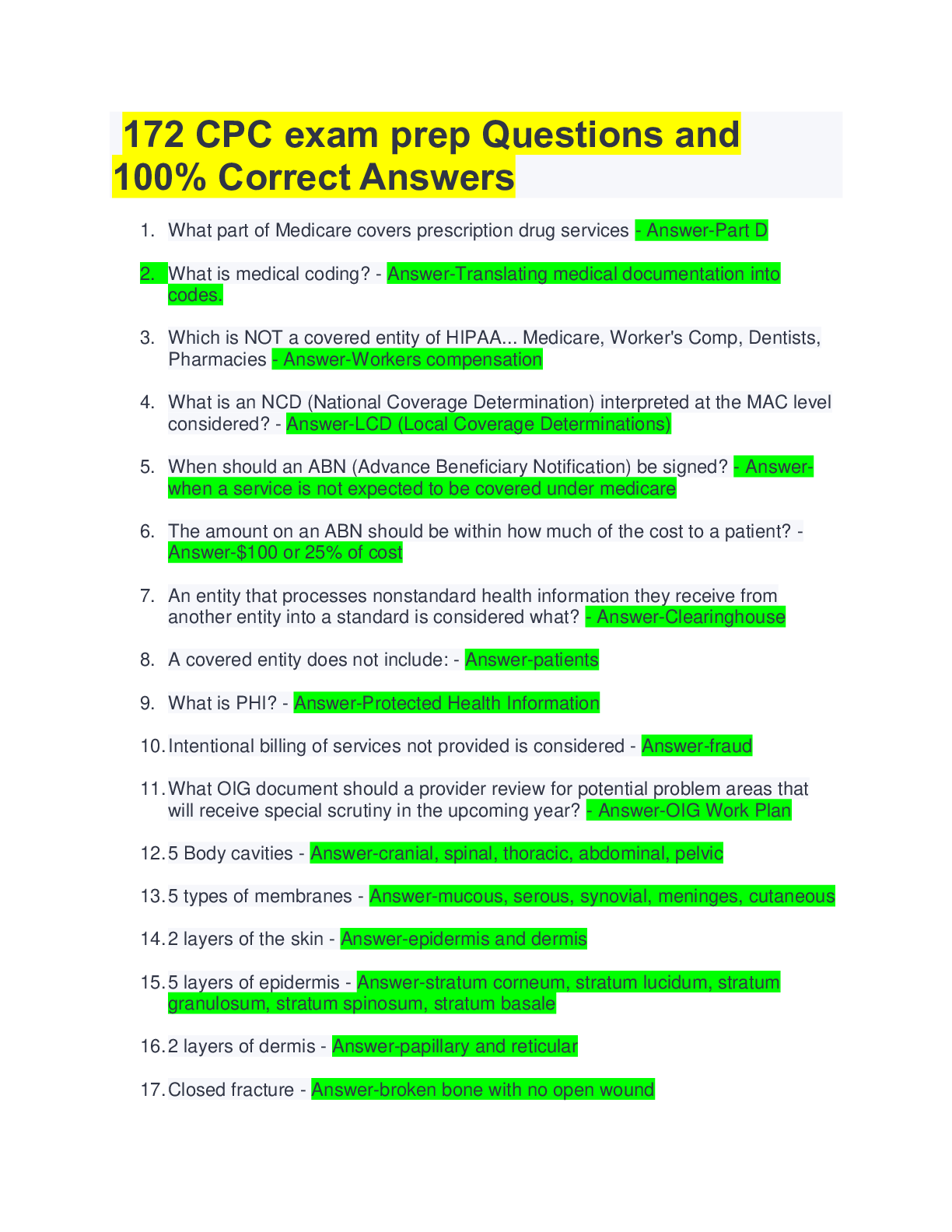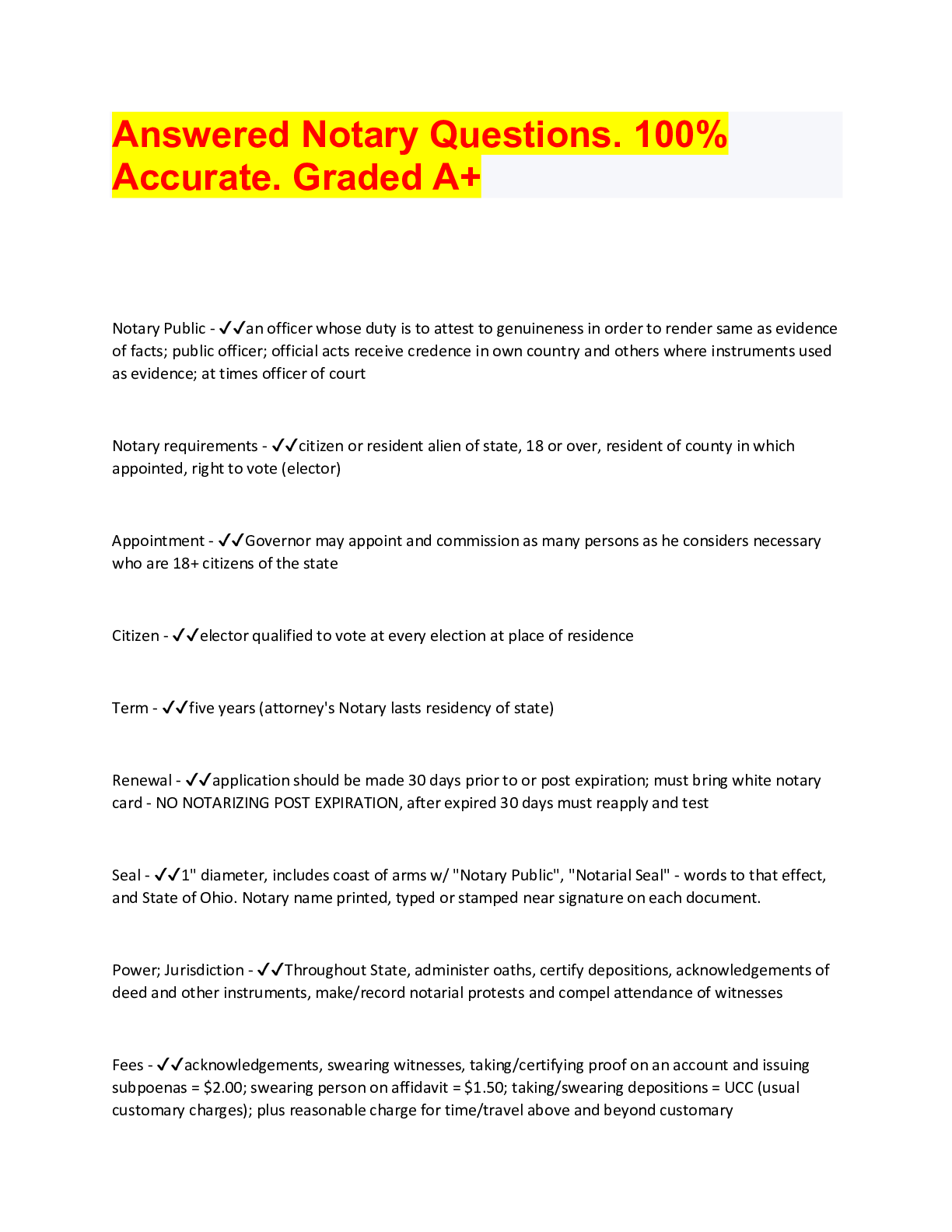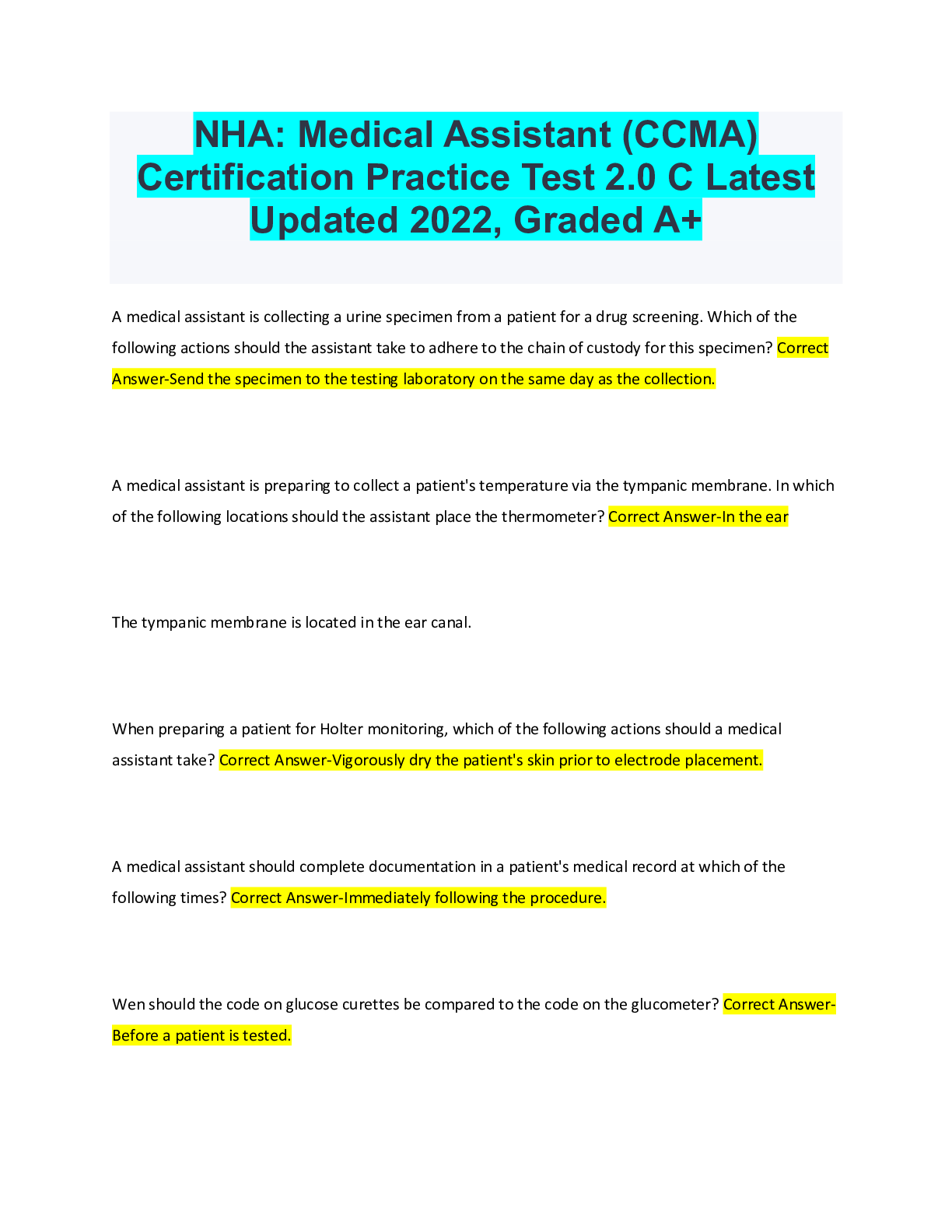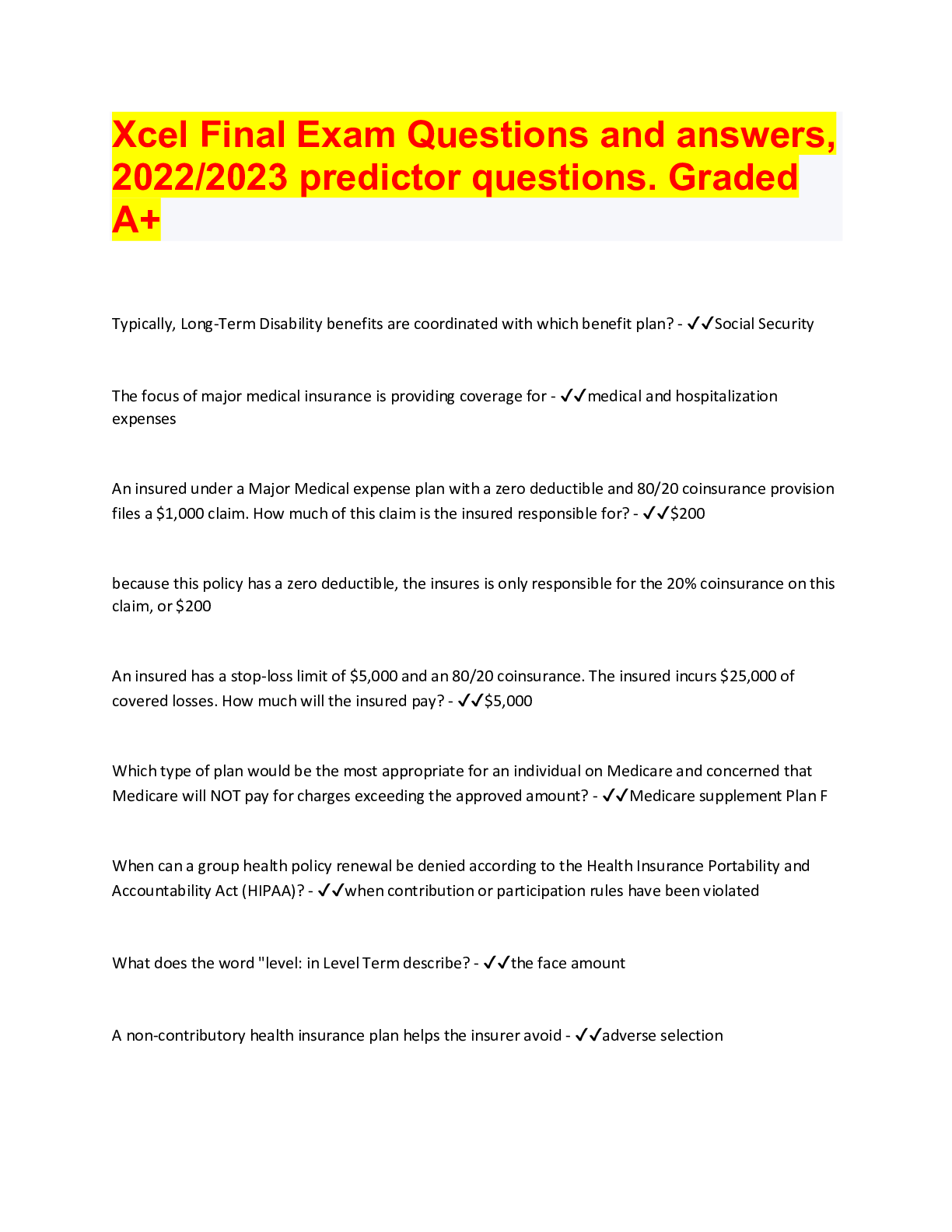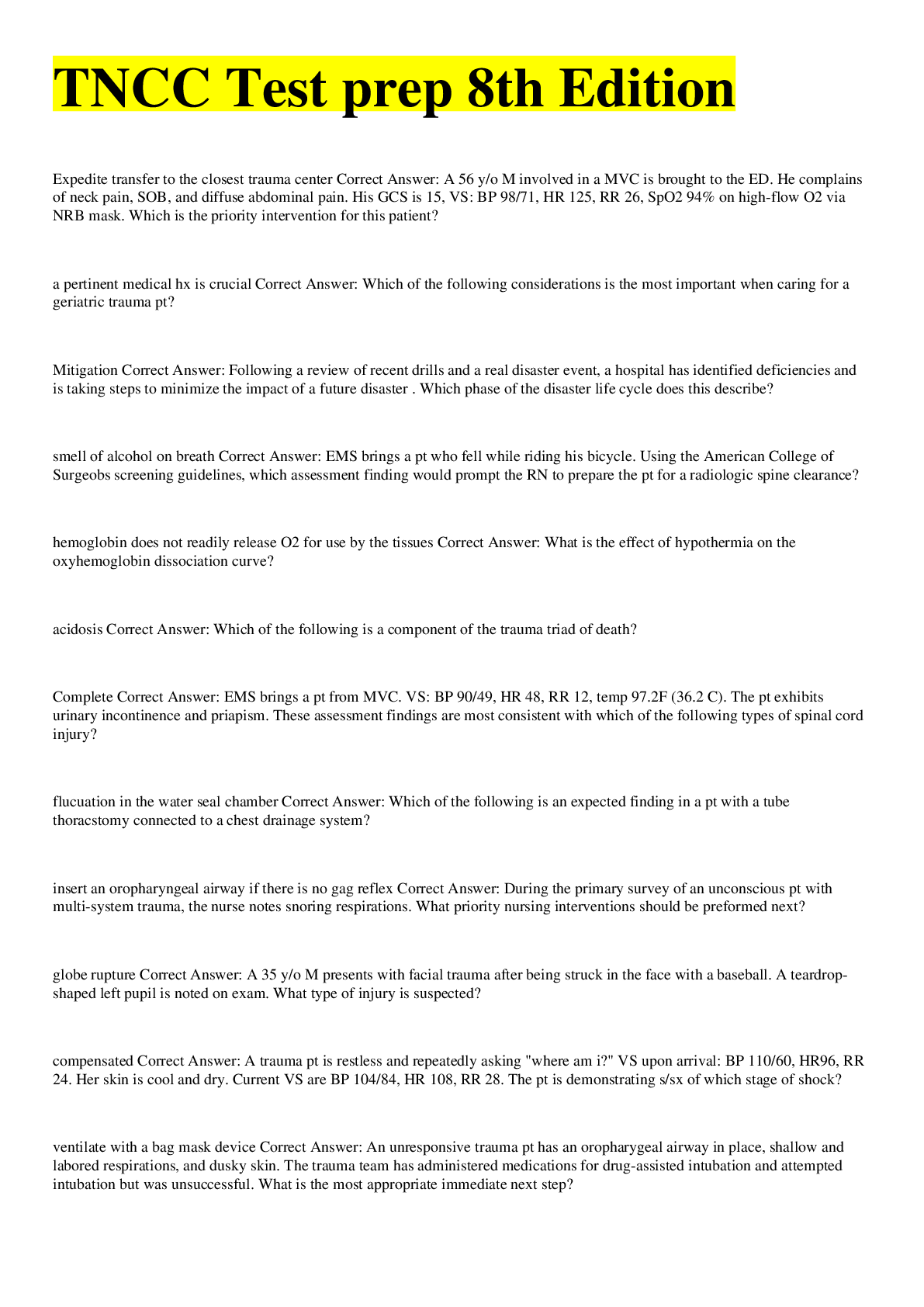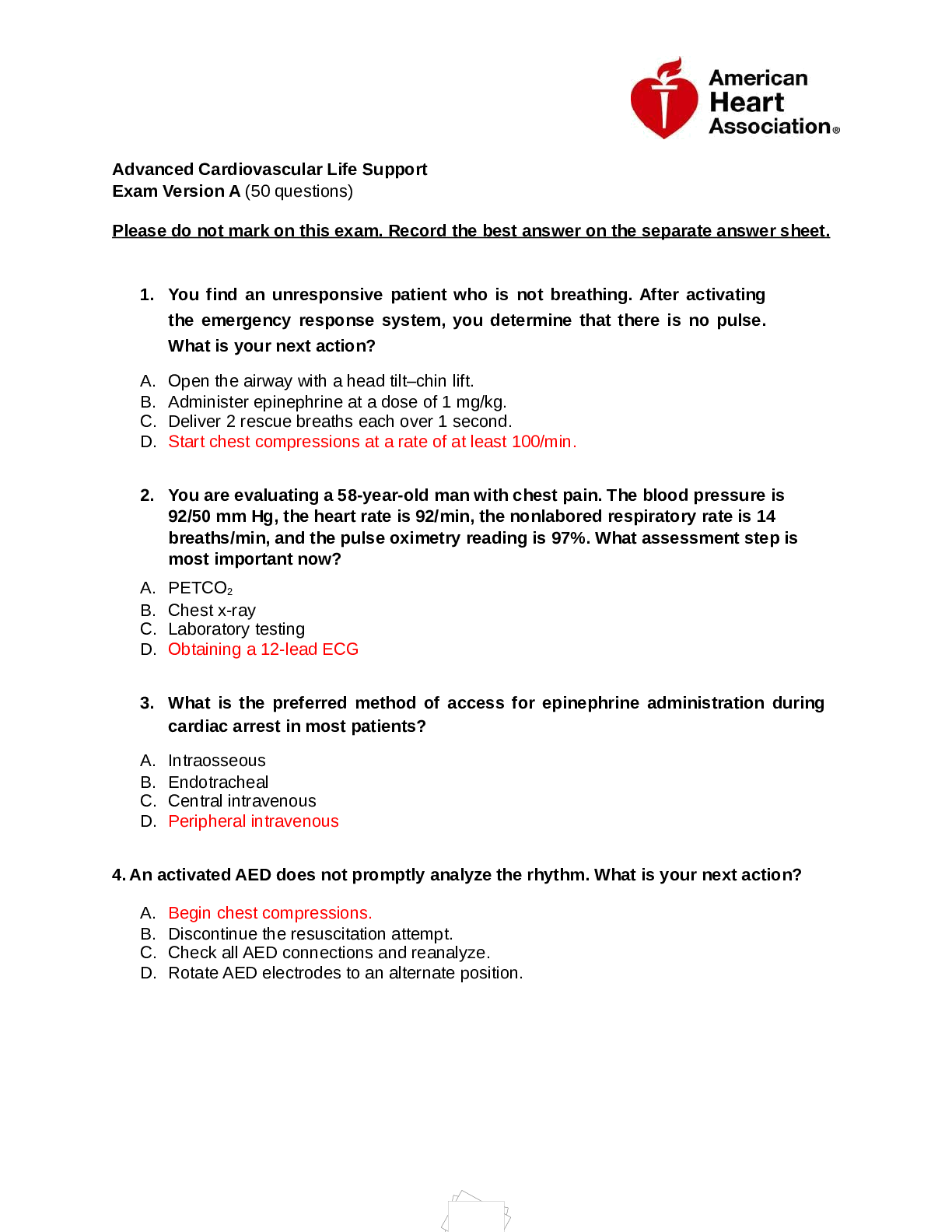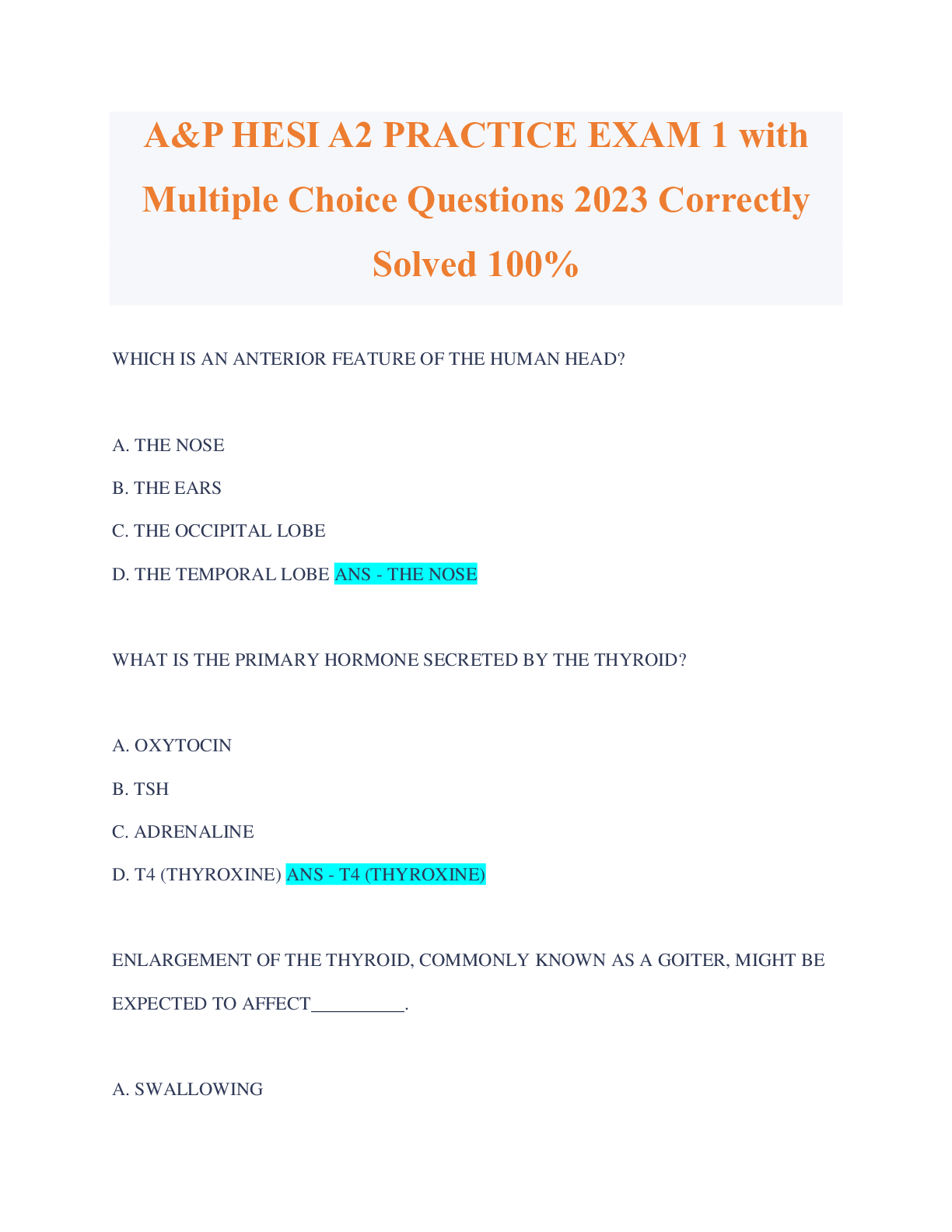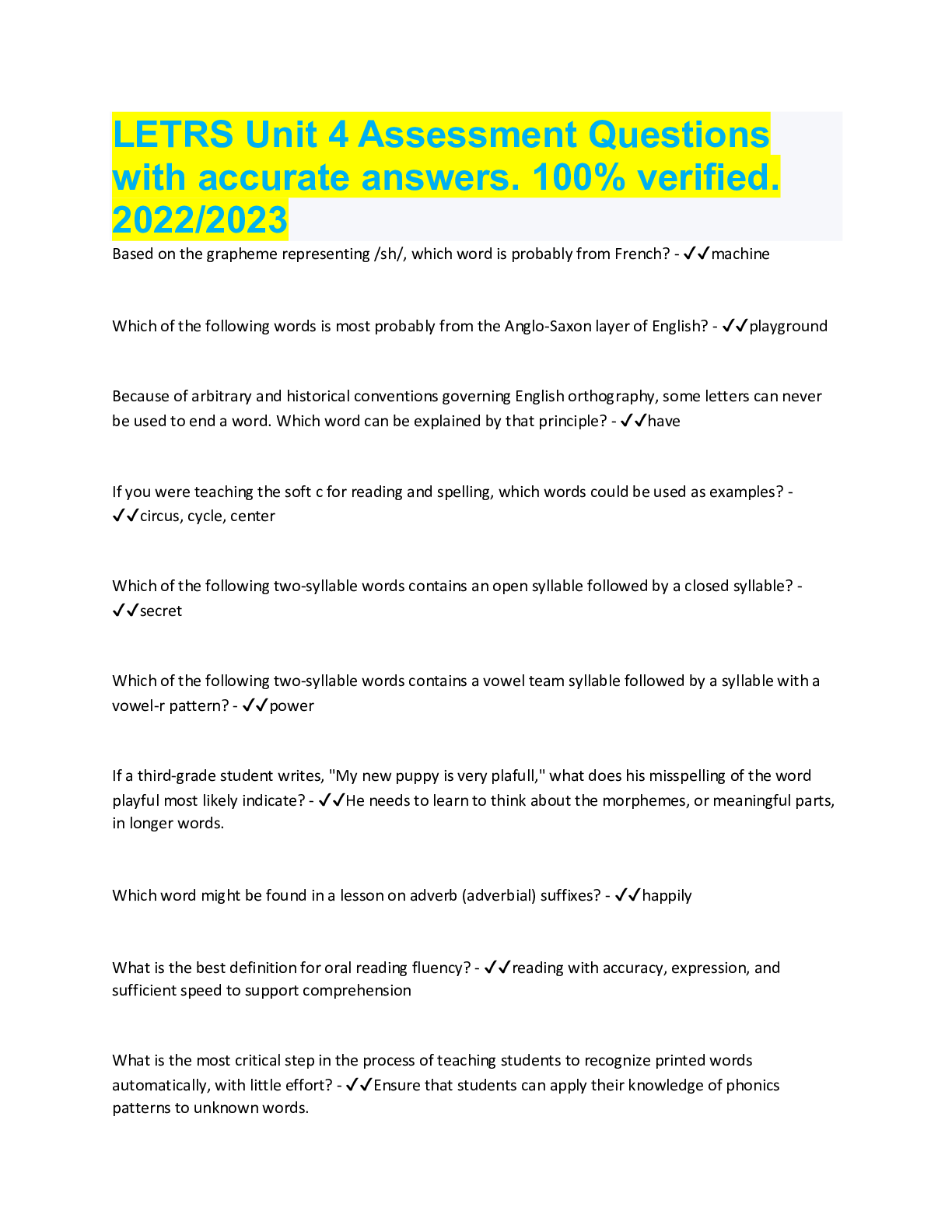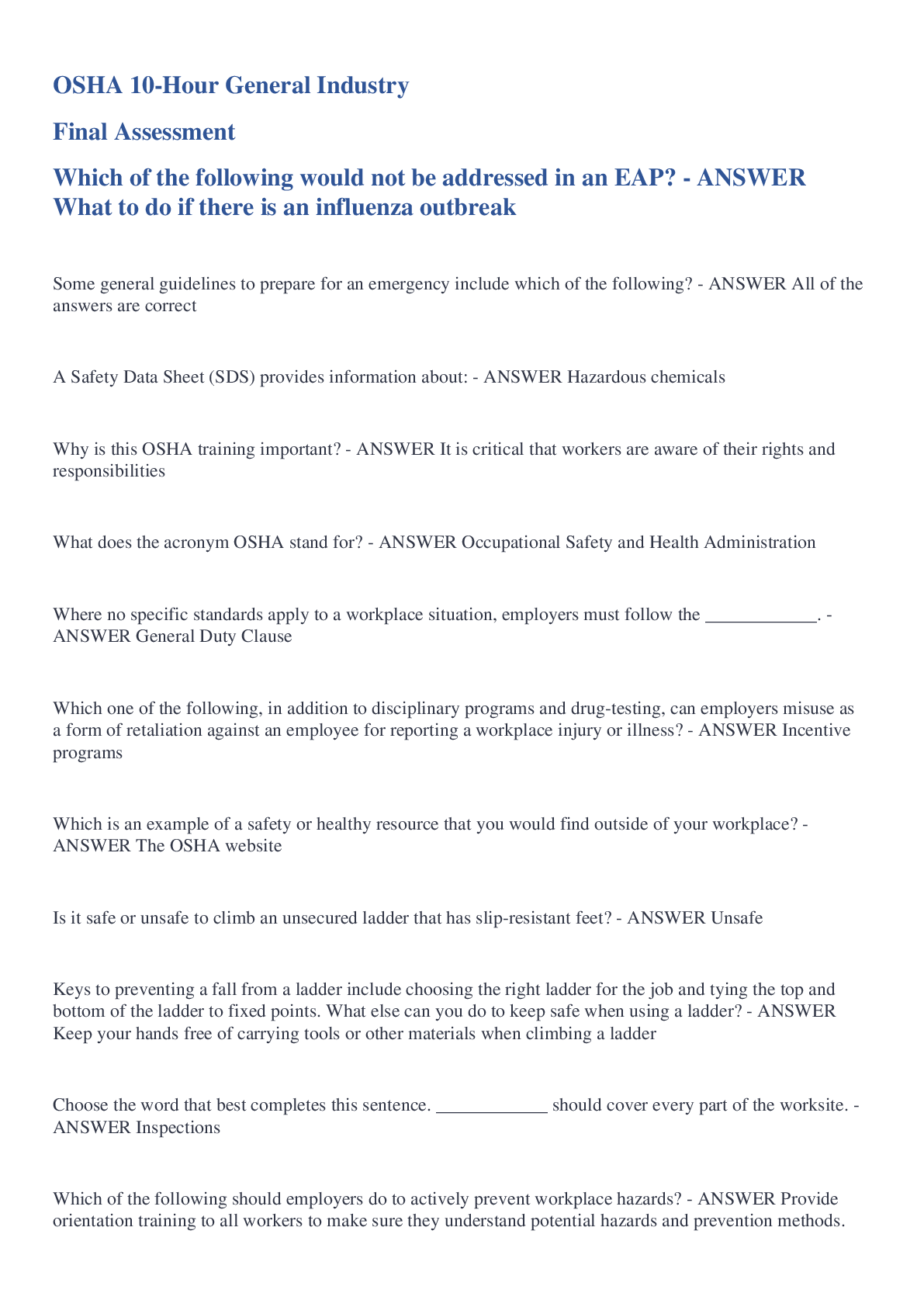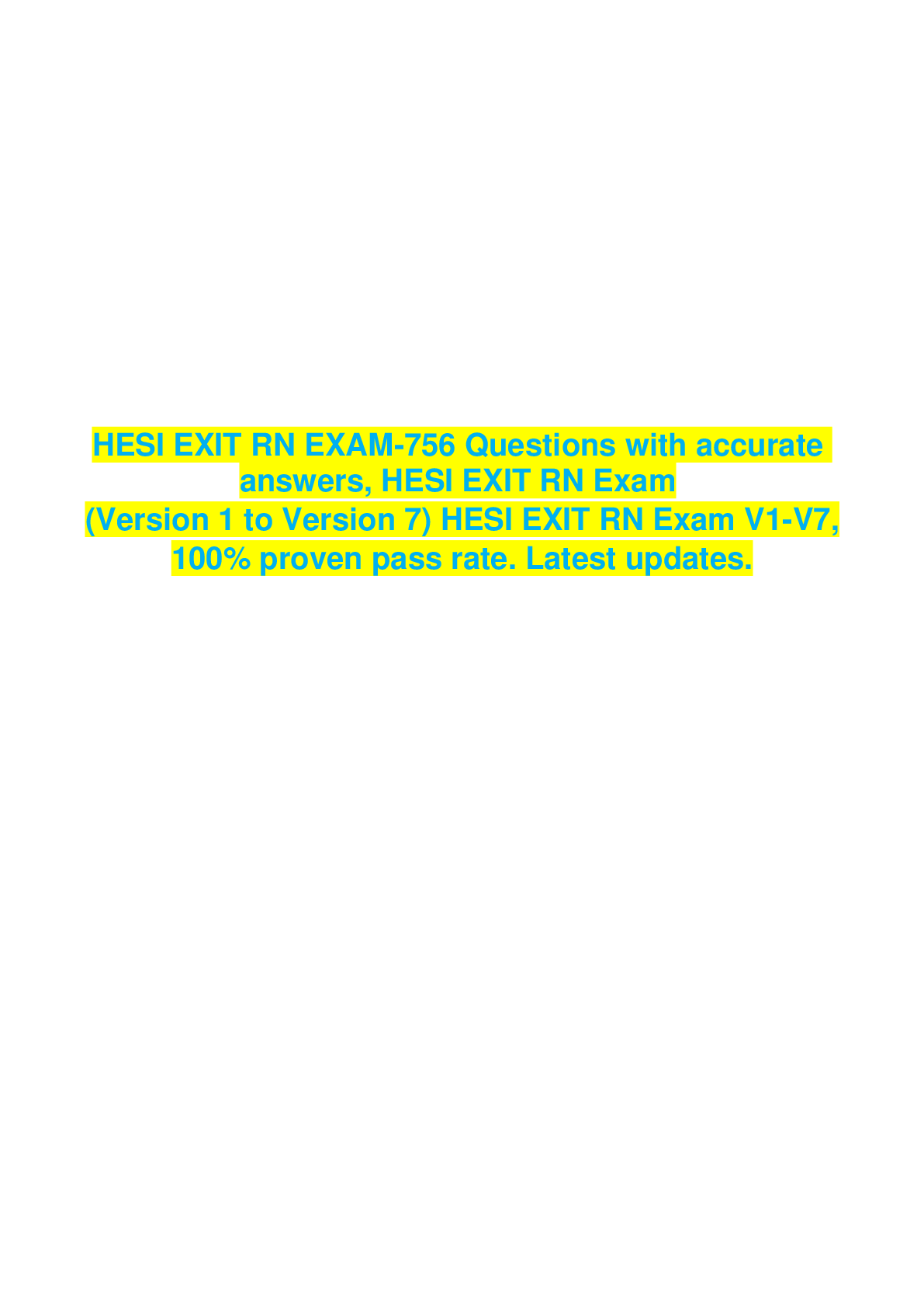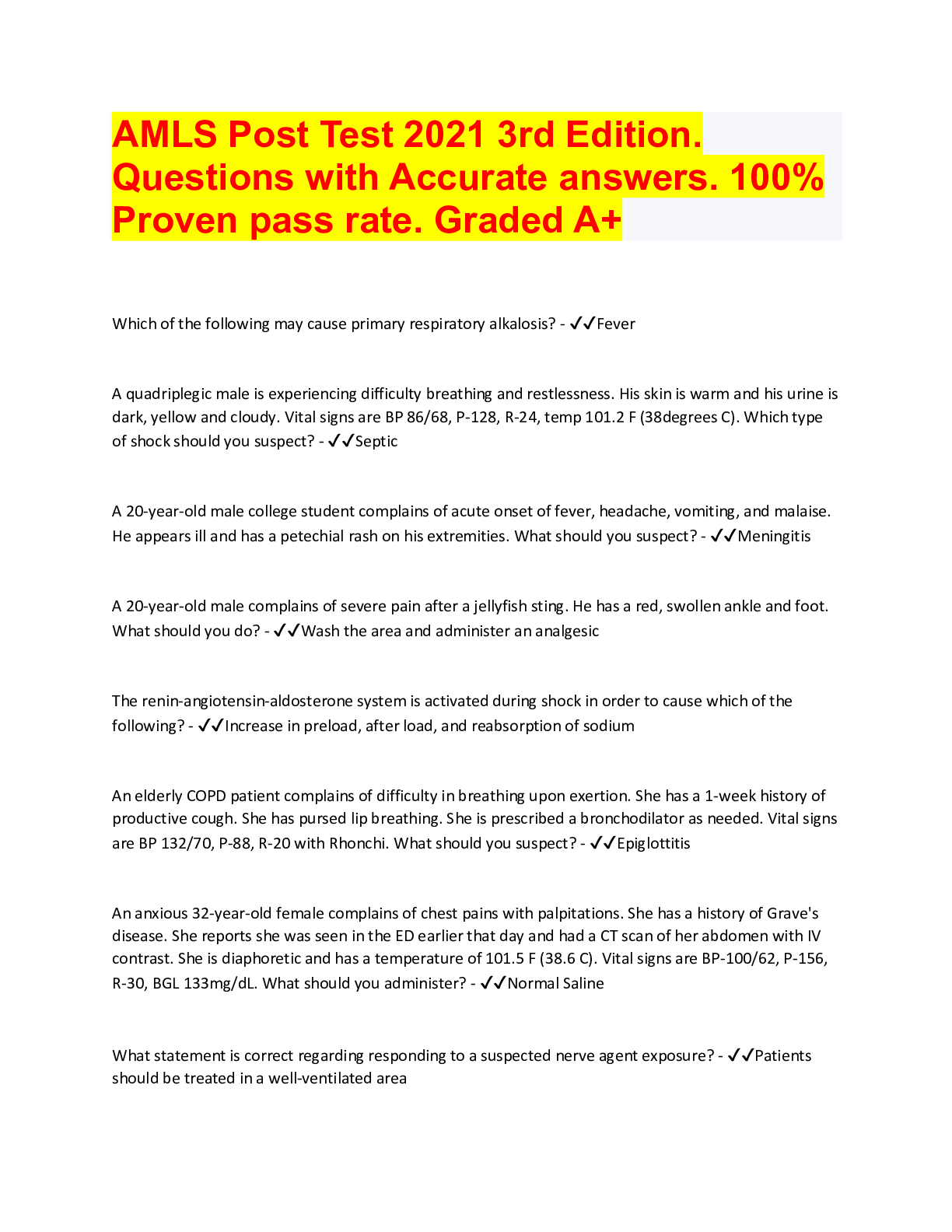*NURSING > QUESTIONS & ANSWERS > NREMT Practice Test Bank - Multiple Choice Questions with Accurate answers. 100% proven pass rate. (All)
NREMT Practice Test Bank - Multiple Choice Questions with Accurate answers. 100% proven pass rate.
Document Content and Description Below
Hypoglycemia and acute ischemic stroke can present similarly because: • A:both oxygen and glucose are needed for brain function. • B:the majority of stroke patients have a history of diabetes.... • C:the most common cause of a stroke is hypoglycemia. • D:they are both caused by low levels of glucose in the blood. - ☑☑• A:both oxygen and glucose are needed for brain function. Reason: Although stroke and hypoglycemia are two distinctly different conditions, their signs and symptoms are often similar. This is because the brain requires both oxygen and glucose to function normally. An acute ischemic stroke is caused by a lack of oxygen to a part of the brain due to a blocked cerebral artery, whereas hypoglycemia (low blood glucose level) deprives the entire brain of glucose. In either case, the patient presents with signs of impaired brain function (ie, slurred speech, weakness, altered mental status). Both conditions may lead to permanent brain damage or death if not treated promptly. When dealing with an emotionally disturbed patient, you should be MOST concerned with: • A:gathering all of the patient's medications. • B:safely transporting to the hospital. • C:whether the patient could harm you. • D:obtaining a complete medical history. - ☑☑You selected C; This is correct! Reason: When managing any patient with an emotional or psychiatric crisis, your primary concern is your own safety. Safely transporting the patient to the hospital is your ultimate goal. If possible, you should attempt to obtain a medical history and should take any of the patient's prescribed medications to the hospital. However, this should not supercede your own safety or interfere with safely transporting the patient. You are at the scene where a man panicked while swimming in a small lake. Your initial attempt to rescue him should include: • A:rowing a small raft to the victim. • B:reaching for the victim with a long stick. • C:throwing a rope to the victim. • D:swimming to the victim to rescue him. - ☑☑You selected B; This is correct! Reason: General rules to follow when attempting to rescue a patient from the water include "reach, throw, row, and then go." In this case, you should attempt to reach the victim by having him grab hold of a large stick or similar object. If this is unsuccessful, throw the victim a rope or flotation device (if available). If these are not available, row to the patient in a small raft (if available). Going into the water to retrieve the victim is a last resort. The rescuer must be a strong swimmer because patients who are in danger of drowning are in a state of blind panic and will make every attempt to keep themselves afloat, even if it means forcing the rescuer underwater. How should you classify a patient's nature of illness if he or she has a low blood glucose level, bizarre behavior, and shallow breathing? • A:Behavioral emergency • B:Altered mental status • C:Respiratory emergency • D:Cardiac compromise - ☑☑The correct answer is B; Reason: The nature of illness (NOI) is the medical equivalent to mechanism of injury (MOI). Altered mental status should be the suspected NOI in any patient with any fluctuation in level of consciousness, which can range from bizarre behavior to complete unresponsiveness. Causes of an altered mental status include hypo- or hyperglycemia, head trauma, stroke, behavioral crises, drug overdose, and shock, among others. A young female is unresponsive after overdosing on an unknown type of drug. Her respirations are slow and shallow and her pulse is slow and weak. Which of the following drugs is the LEAST likely cause of her condition? • A:Seconal • B:Heroin • C:Cocaine • D:Valium - ☑☑The correct answer is C; Reason: Of the drugs listed, cocaine would be the least likely cause of the patient's condition. Cocaine is a central nervous system (CNS) stimulant; you would expect her to be hypertensive, tachycardic, tachypneic, and perhaps even violent. Heroin, Valium, and Seconal are all CNS depressants and could explain her condition. Heroin is an illegal narcotic (opiate), Valium is a benzodiazepine sedative-hypnotic drug, and Seconal is a barbiturate. Narcotics, benzodiazepines, and barbiturates are all CNS depressants. When taken in excess, they cause a decreased level of consciousness, respiratory depression, bradycardia, and hypotension. Activated charcoal is contraindicated for a patient who is: • A:conscious and alert and has ingested a large amount of Motrin. • B:emotionally upset and has ingested two bottles of aspirin. • C:agitated and claims to have ingested a bottle of Tylenol. • D:awake and alert and has swallowed a commercial drain cleaner. - ☑☑You selected D; This is correct! Reason:Activated charcoal adsorbs (sticks to) many ingested substances, preventing them from being absorbed into the body by the stomach or intestines. In some cases, you may give activated charcoal to patients who have ingested certain substances, if approved by medical control or local protocol. Activated charcoal is contraindicated for patients who have ingested an acid or alkali (ie, drain cleaner) or a petroleum product (ie, gasoline), who have a decreased level of consciousness and cannot protect their own airway, or who are unable to swallow. The MOST obvious way to reduce heat loss from radiation and convection is to: • A:move away from a cold object. • B:increase metabolism by shivering. • C:wear a thick wind-proof jacket. • D:move to a warmer environment. - ☑☑you selected D; This is correct! Reason:In a cold environment, the body has two ways of staying warm: generating heat (thermogenesis) and reducing heat loss. Radiation is the transfer of heat by radiant energy. The body can lose heat by radiation, such as when a person stands in a cold room. Convection occurs when heat is transferred to circulating air, as when cool air moves across the body's surface. A person standing in windy cold weather, wearing lightweight clothing, is losing heat to the environment mostly by convection. The quickest and most obvious way to decrease heat loss from radiation and convection is to move out of the cold environment and seek shelter from wind. Shivering increases the body's metabolism and is a mechanism for generating heat, not reducing heat loss. Layers of clothing trap air and provide excellent insulation; thus, layered clothing decreases heat loss better than a single, thick jacket. Conduction is the direct transfer of heat from a part of the body to a colder object by direct contact, as when a warm hand touches cold metal or ice. The most obvious way to decrease heat loss by conduction is to remove your hand from the cold object. A near-drowning is MOST accurately defined as: • A:complications within 24 hours following submersion in water. • B:immediate death due to prolonged submersion in water. • C:survival for at least 24 hours following submersion in water. • D:death greater than 24 hours following submersion in water. - ☑☑You selected C; This is correct! Reason:Collectively, drowning and near-drowning are referred to as submersion injuries. Drowning is defined as death after submersion in a liquid medium, usually water. In a drowning, death is either immediate or occurs within 24 hours following submersion. Near-drowning is defined as survival, at least temporarily (24 hours), after submersion. It should be noted, however, that complications such as pneumonia and pulmonary edema can cause death greater than 24 hours following submersion. For this reason, all patients with a submersion injury should be transported to the hospital, even if they appear fine at the scene. A young woman reports significant weight loss over the last month, persistent fever, and night sweats. When you assess her, you note the presence of dark purple lesions covering her trunk and upper extremities. You should suspect: • A:end-stage cancer. • B:HIV/AIDS. • C:tuberculosis. • D:rheumatic fever. - ☑☑You selected B; This is correct! Reason:Weight loss, fever, and night sweats could indicate tuberculosis or HIV/AIDS; however, the dark purple lesions on the skin, which are called Kaposi's sarcoma, are malignant skin tumors and are a classic finding in patients in the later stages of AIDS. A 48-year-old male became acutely hypoxic, experienced a seizure, and is now postictal. The MOST effective way to prevent another seizure is to: • A:dim the lights in the back of the ambulance. • B:place him in the recovery position. • C:administer high-flow supplemental oxygen. • D:give him oral glucose if he can swallow. - ☑☑You selected C; This is correct! Reason:You should administer high-flow oxygen to all patients who are actively seizing and to patients who experienced a seizure and are postictal. This is especially true if the seizure was caused by hypoxia. Increasing the oxygen content of the blood, which minimizes hypoxia, may prevent another seizure. The recovery position is appropriate for uninjured patients with a decreased level of consciousness and adequate breathing; it will help maintain the airway and facilitate drainage of secretions from the mouth, but will not prevent another seizure. Oral glucose may prevent another seizure if hypoglycemia was the cause of the seizure. You should dim the lights in the back of the ambulance to help prevent any seizure, not just those that are caused by hypoxia. Which of the following conditions would be the LEAST likely to be present in a patient who was submerged in water? • A:Spinal injury • B:Gastric distention • C:Hyperglycemia • D:Laryngospasm - ☑☑You selected C; This is correct! Reason: Many factors can contribute to or result from a submersion injury (eg, drowning, near-drowning). It is not uncommon for a person to experience a spinal injury after diving head first into shallow water, especially if he or she is under the influence of alcohol. When a swimmer panics, he or she initially swallows large amounts of water, resulting in gastric distention. Gastric distention can cause aspiration if the patient regurgitates water during rescue breathing; protect the airway! During the panic phase, the victim expends a tremendous amount of energy (and glucose) from flailing around in the water, possibly resulting in hypoglycemia. Inhaling even a small amount of fresh or salt water can severely irritate the larynx, which sends the muscles of the larynx and vocal cords into spasm (laryngospasm), resulting in airway blockage and hypoxia. A 42-year-old male presents with fever, a severe headache, and a stiff neck. He is conscious, but confused. His wife tells you that he does not have any medical problems and does not take any medications. You should be MOST suspicious for: • A:acute stroke. • B:influenza. • C:meningitis. • D:tuberculosis. ( - ☑☑You selected C; This is correct! Reason:Meningitis is an inflammation of the protective coverings of the brain and spinal cord (meninges). Common signs and symptoms of meningitis include fever, headache, neck stiffness (nuchal rigidity), and vomiting. An altered mental status is common in severe cases. Meningococcal meningitis, caused by a bacterium, is the most contagious and potentially fatal type of meningitis. The patient's signs and symptoms are not consistent with acute stroke, tuberculosis (TB), or influenza (the flu). Although fever is common with both TB and the flu, neither causes neck stiffness. Acute stroke may be associated with a headache, especially a hemorrhagic stroke; however, stroke patients typically do not have a fever. All of the following are signs of gastrointestinal bleeding, EXCEPT: • A:melena. • B:hematemesis. • C:tachycardia. • D:hemoptysis. - ☑☑You selected D; This is correct! Reason:Signs and symptoms of gastrointestinal (GI) bleeding include abdominal pain; vomiting blood (hematemesis); the passage of dark, tarry stools (melena); and bright red rectal bleeding (hematochezia). If blood loss is significant, the patient may have signs of shock (eg, tachycardia, diaphoresis, tachypnea, hypotension). Hemoptysis (coughing up blood) is a sign of a pulmonary injury, not GI bleeding. A 24-year-old female presents with a rash to her left leg and swollen, painful knee joints. She tells you that she and her friends returned from a hiking trip in the mountains a week ago. She is conscious and alert with a blood pressure of 112/62 mm Hg, a pulse of 84 beats/min, and respirations of 14 breaths/min. Her symptoms are MOST likely the result of: • A:Rocky Mountain spotted fever. • B:tetanus. • C:Lyme disease. • D:a localized allergic reaction. - ☑☑You selected C; This is correct! Reason:The patient's symptoms and her history of a recent hiking trip are consistent with Lyme disease, which was the result of a tick bite. Ticks can carry two infectious diseases: Lyme disease and Rocky Mountain spotted fever. Both are spread through the tick's saliva, which is injected into the skin when the tick attaches itself. The first symptom of Lyme disease, a rash that may spread to several parts of the body, begins about 3 days after the bite of an infected tick. The rash may eventually resemble a target bull's-eye pattern in one third of patients. After a few more days or weeks, painful swelling of the joints, particularly the knees, occurs. If recognized and treated promptly with antibiotics, many patients recover completely. Rocky Mountain spotted fever, which is not limited to the Rocky Mountains, occurs within 7 to 10 days after being bitten by an infected tick. Its symptoms include nausea, vomiting, headache, weakness, paralysis, and possibly cardiopulmonary failure. A 50-year-old woman who is conscious and alert complains of a severe migraine headache. When caring for her, you should generally avoid: • A:transporting her in a supine position. • B:shining a light into her pupils. • C:dimming the lights in the ambulance. • D:applying ice packs to her forehead. - ☑☑You selected B; This is correct! Reason:Patients with migraine or cluster headaches typically have photophobia (light sensitivity). Any type of bright light, especially if shone directly into the eyes, will cause the patient with a headache unnecessary severe pain. Dimming the lights in the ambulance and making the patient as comfortable as possible are the treatments of choice for a patient with a headache. Some patients benefit from ice packs applied to the forehead; just be sure to wrap the ice pack with roller gauze. Oxygen also should be administered as needed. Typically, the patient will prefer to lie supine or on the side A patient who overdosed on heroin would be expected to present with: • A:tachycardia. • B:hyperpnea. • C:hypotension. • D:dilated pupils. - ☑☑The correct answer is C; Reason:Heroin is a Schedule I (illegal) narcotic that is typically injected. As with all narcotics, legal or illegal, overdose causes depression of the central nervous system (CNS), resulting in a decreased level of consciousness; bradycardia; hypotension; and slow, shallow (reduced tidal volume) breathing. Hyperpnea (deep breathing) would not be present in a patient who overdosed on a narcotic. In a narcotic overdose, the pupils are typically constricted (miosis). Barbiturates, such as phenobarbital, are also CNS depressants and cause the same symptoms seen with narcotic overdose. The patient's pupils, however, are typically dilated (mydriasis), not constricted. When caring for any patient with a decreased level of consciousness, your primary concern should be the: • A:potential for airway compromise. • B:patient's blood glucose level. • C:possibility of a spinal injury. • D:possibility of a drug overdose. - ☑☑You selected A; This is correct! Reason:Altered mental status could be caused by a high or low blood glucose level, drug overdose, or head injury, among other causes. Furthermore, the possibility of a spinal injury should be considered if the patient was injured. However, your primary concern should be the status of the patient's airway. Patients with a decreased level of consciousness are at risk for aspiration if vomiting occurs. Unless spinal trauma is present or the patient is breathing inadequately (eg, fast or slow rate, shallow breathing [reduced tidal volume]), place him or her in the recovery position to facilitate drainage if vomiting occurs. Remember this: no airway, no patient! A 16-year-old, 125-pound male ingested a bottle of aspirin approximately 20 minutes ago. Medical control orders you to administer activated charcoal in a dose of 1 g/kg. How much activated charcoal should you administer? • A:54 g • B:60 g • C:51 g • D:57 g - ☑☑You selected D; This is correct! Reason: First, you must determine the patient's weight in kilograms (kg). Either of the following formulae can be used to convert pounds to kilograms: Formula 1: weight (in pounds) ÷ 2.2 = weight in kg. Formula 2: weight (in pounds) ÷ 2 - 10% = weight in kg. On the basis of the above formulae, a 125-pound patient weighs 57 kg. Using formula 1, the equation is as follows: 125 (weight in pounds) ÷ 2.2 = 56.81 (57 [rounded to the nearest tenth]). Using formula 2, the equation is as follows: 125 (weight in pounds) ÷ 2 = 62.5 (63 [rounded to the nearest tenth] - 6.3 (10% of 63) = 56.7 (57 [rounded to the nearest tenth]). Since the drug order is for 1 g/kg, you should administer 57 g of activated charcoal to your 125-pound patient. Which of the following is the MOST significant finding in a patient with a severe headache? • A:Pain in both legs • B:Chest discomfort • C:Unilateral weakness • D:Abdominal tenderness - ☑☑You selected C; This is correct! Reason: Unilateral weakness (weakness on one side of the body) is a clinically significant finding in a patient with a headache because it could indicate a stroke (ischemic or hemorrhagic). Abdominal, chest, and leg pain are not common complaints associated with a headache, although they should be noted and investigated if they are present. When caring for a patient with severe hypothermia who is in cardiac arrest, you should: • A:perform rescue breathing only. • B:perform BLS and transport. • C:avoid using the AED. • D:hyperventilate the patient. - ☑☑The correct answer is B; Reason:Patients with severe hypothermia (core body temperature < 86°F) who are in cardiac arrest should be managed with basic life support (chest compressions and ventilations), passive external rewarming (ie, removal of wet clothing, applying warm blankets) and rapid transport to the hospital where they can be actively rewarmed. Because cold muscle is a poor conductor of electricity, defibrillation, if indicated, should be limited to 1 attempt until the patient's body temperature has been increased. Cardiac arrest patients with severe hypothermia generally do not respond to defibrillation. Hyperventilation should be avoided as this may increase intrathoracic pressure and impair blood flow back to the heart. You should not attempt to actively rewarm a patient with moderate or severe hypothermia in the field because: • A:rewarming too quickly can cause a fatal cardiac dysrhythmia. • B:the risk of inadvertently inducing hyperthermia is too high. • C:it is painful for the patient and you cannot give analgesic drugs. • D:active rewarming has been shown to cause severe hypertension. - ☑☑You selected A; This is correct! Reason:When caring for a patient with hypothermia, your goal is to prevent further heat loss; this involves removing wet clothing, applying warm blankets, and allowing the patient's body temperature to rise gradually and naturally (passive rewarming). If the patient is moderately or severely hypothermic, you should not try to rewarm him or her actively (placing heat on or into the body). Rewarming too quickly may cause a fatal cardiac dysrhythmia, such as ventricular fibrillation (V-Fib). Active rewarming may also cause rewarming shock, a condition in which the blood vessels dilate when heat is applied to the body, resulting in significant hypotension. For these reasons, active rewarming should only be performed in the controlled setting of a hospital. You respond to a grocery store where a 39-year-old man reportedly experienced a seizure. When you arrive at the scene, a clerk begins to escort you to the patient. She tells you that the man stopped seizing about 5 minutes ago. If the patient truly experienced a seizure, you will MOST likely find that he: • A:has a slow heart rate. • B:is fully conscious and alert. • C:is not breathing and is cyanotic. • D:is confused and disoriented. - ☑☑You selected D; This is correct! Reason: Most seizures are followed by a postictal phase, in which the patient is unresponsive at first and then gradually regains consciousness. In most cases, the postictal patient appears dazed, confused, or disoriented; in some cases, he or she is combative. The postictal phase typically lasts from 5 to 30 minutes. During the seizure, the patient is often not breathing or is breathing inadequately; however, when the seizure stops, breathing usually resumes. You will also find that most postictal patients are tachycardic; this is the result of an adrenalin surge that occurs during the tonic-clonic phase of the seizure. You are called to a local park for an ill person. It is a hot day and the humidity is high. When you arrive, a bystander directs you to the patient, a young male who is semiconscious. His skin is flushed, hot, and moist. Your FIRST action in the management of this patient should be to: • A:begin rapid cooling measures. • B:ensure an open airway. • C:administer high-flow oxygen. • D:move him to a cool area. - ☑☑You selected D; This is correct! Reason:Your first action in a heat-related emergency is to move the patient to a cooler environment. Once you have moved the patient to a cooler place, you should begin your assessment and treat the patient accordingly. Remember, you must FIRST prevent further harm to the patient. A known diabetic female is found unresponsive. Her respirations are rapid and shallow; her skin is cool, clammy, and pale; and her pulse is rapid and weak. Which of the following would BEST explain the likely cause of her condition? • A:Failure to take insulin • B:Insulin overdose • C:Excessive eating • D:High blood sugar - ☑☑The correct answer is B; Reason:The patient has classic signs of insulin shock, a condition caused by a low blood glucose level (hypoglycemia). Common causes of insulin shock include insulin overdose (accidental or intentional), failure to eat (or not eating enough), and excessive exertion. The patient's symptoms are not consistent with diabetic ketoacidosis (DKA), a condition that results from a high blood glucose level (hyperglycemia). Signs of DKA include deep, rapid breathing with a fruity or acetone breath odor (Kussmaul respirations), and warm, dry skin. Unlike insulin shock, which can result from an insulin overdose, DKA can occur if a patient fails to take his or her insulin or takes too little. You are dispatched to a residence for a 20-year-old male with respiratory distress. When you arrive, you find that the patient has a tracheostomy tube and is ventilator dependent. His mother tells you that he was doing fine, but then suddenly began experiencing breathing difficulty. You should: • A:detach the ventilator, suction the tracheostomy tube, and reassess the patient. • B:remove the ventilator tubing and place an oxygen mask over the tracheostomy tube. • C:remove him from the mechanical ventilator and ventilate him manually. • D:check the settings on the ventilator to ensure that it is functioning properly. - ☑☑you selected C; This is correct! Reason:If a ventilator-dependent patient experiences a sudden onset of respiratory distress, you should first remove him or her from the mechanical ventilator and begin manual ventilation with a bag-mask device; if the patient improves, you will know that the problem was a malfunction with the mechanical ventilator. If the patient does not improve, the tracheostomy tube is likely plugged with thick mucus secretions and requires suctioning. Unless you are familiar with the mechanical ventilator (most EMTs are not), do not attempt to troubleshoot the device by checking the settings; this only wastes time. A middle-aged man was found floating facedown in a small pond. When you arrive at the scene, bystanders are present, but nobody has removed him from the water because they thought he was dead. After reaching the victim, you should: • A:float a buoyant backboard under him, remove him from the pond, and begin rescue breathing. • B:move him to a supine position by rotating the entire upper half of his body as a single unit. • C:stabilize his head as you remove it from the water and open his airway by tilting his head back. • D:grab him by his clothing, remove him from the pond, and assess for breathing and a pulse. - ☑☑The correct answer is B; Reason:After safely reaching a drowning victim, you should first turn him to a supine position by rotating the entire upper half of the body as a single unit; protect the cervical spine as you do this because a spinal injury cannot be ruled out. Open the patient's airway, without manipulating the neck, and begin rescue breathing while still in the water. Float a buoyant backboard under the patient, secure him to it, and remove him from the water. After removing the victim from the water, assess for a pulse. If the victim is pulseless, begin CPR, dry him off, and apply the AED as soon as possible. Which of the following patients with diabetes is the BEST candidate for oral glucose? • A:A confused patient who has cool, clammy skin • B:A semiconscious patient with pale, clammy skin • C:An unresponsive patient who took too much insulin • D:A confused patient with suspected hyperglycemia - ☑☑You selected A; This is correct! Reason:Oral glucose is indicated for patients with diabetes who are in insulin shock (hypoglycemic crisis), or for any patient with symptomatic hypoglycemia (as documented by glucometer). The patient must be conscious and alert enough to be able to swallow the glucose, which comes in a tube of gel. If the patient is unresponsive or otherwise unable to swallow the glucose, you should provide rapid transport, providing the appropriate airway management en route, and consider an ALS intercept. A 40-year-old woman presents with widespread hives that she noticed about 45 minutes after taking penicillin. She is conscious and alert and denies difficulty breathing. Her breath sounds are clear to auscultation bilaterally, her vital signs are stable, and her oxygen saturation is 94%. She tells you she is allergic to wasps and has an epinephrine auto-injector. You should: • A:assist her in administering epinephrine via her auto-injector. • B:give high-flow oxygen and administer 100 mg of Benadryl. • C:give supplemental oxygen and transport her to the hospital. • D:advise her that she can probably drive herself to the hospital. - ☑☑You selected C; This is correct! Reason:The patient is experiencing an allergic reaction, but she is not in anaphylactic shock. Urticaria (hives) is common to all allergic reactions, regardless of severity; however, wheezing and hypotension, which she does not have, are specific to anaphylaxis. Although she carries an epinephrine auto-injector for her allergy to wasps, she was not stung by a wasp. Furthermore, the absence of wheezing and hypotension negates epinephrine administration. Give supplemental oxygen (in a concentration sufficient to maintain an SpO2 of greater than 94%) and transport her to the hospital. Because it can take up to an hour for signs of a severe allergic reaction to manifest, the patient should not drive herself. Diphenhydramine (Benadryl), an antihistamine, is an appropriate drug based on her presentation; however, it is not typically carried on a BLS unit. Furthermore, the correct dose is 25 to 50 mg. Immediately following a generalized motor seizure, most patients are: • A:hyperactive. • B:confused. • C:apneic. • D:awake and alert. - ☑☑You selected B; This is correct! Reason:After a generalized (grand mal) motor seizure, the patient typically will be confused, sleepy, or in some cases, combative. This is referred to as the postictal phase. The patient's level of consciousness typically improves within 30 minutes. In many cases, the patient's respirations will be fast (tachypnea) following a seizure; this is the body's attempt to eliminate excess carbon dioxide that accumulated in the blood during the seizure. When assessing a conscious patient who overdosed on a drug, you should FIRST determine: • A:if there is a history of prior overdose. • B:the patient's weight in kilograms. • C:the type of medication ingested. • D:when the medication was ingested. - ☑☑You selected C; This is correct! Reason: When assessing a patient who has overdosed on a drug, you should first determine what was ingested, which will provide you with immediate information about whether or not the substance is toxic. You should then find out when the medication was ingested. This information will provide medical control (or poison control) with the information needed to direct the most appropriate treatment. The patient's weight also should be estimated in kilograms in the event that an antidote is required. Information regarding prior drug overdoses would normally be obtained during the SAMPLE history. Which of the following actions should be carried out during the primary assessment of an unresponsive patient? • A:Assessing the skin • B:Obtaining a blood pressure • C:Palpating the cranium • D:Auscultating the lungs - ☑☑You selected A; This is correct! Reason:Components of the primary assessment for both responsive and unresponsive patients include assessing and managing the airway and assessing and managing circulation, which includes controlling any major bleeding; assessing the rate, regularity, and quality of the pulse; and assessing the color, condition, and temperature of the skin. When restraining a violent patient, you should make sure that: • A:the patient is restrained using maximal force. • B:at least two EMTs restrain the patient. • C:consent for restraint has been obtained from a family member. • D:someone talks to the patient during the process. - ☑☑You selected D; This is correct! Reason:If a violent patient needs to be restrained, you must ensure the presence of at least four people (one per extremity). One of the EMTs should continuously talk to the patient to explain what is happening, even if the patient is not listening. Restraint is a last resort used to protect the EMT as well as the patient. Consent is not needed from a family member prior to restraining the patient. Just enough force to effectively restrain the patient is all that is required to prevent causing unnecessary injury. Immediately following a generalized seizure involving tonic-clonic activity, most patients: • A:have a slow heart rate because of cardiac depression during the seizure. • B:are unresponsive but gradually regain consciousness. • C:experience prolonged apnea and require positive-pressure ventilations. • D:return to a normal level of consciousness but cannot recall the event. - ☑☑You selected B; This is correct! Reason:Most generalized (grand mal) seizures last 3 to 5 minutes and are followed by a lengthy (5 to 30 minutes) period called the postictal phase, in which the patient is unresponsive at first but gradually regains consciousness. During the seizure itself, the nervous system releases excess adrenaline (epinephrine); therefore, tachycardia, even after the seizure has stopped, is common. Apnea is common during a seizure; however, breathing usually resumes after the seizure has stopped. Many patients are tachypneic following a seizure; this is the body's attempt to eliminate excess carbon dioxide that accumulated in the blood during the seizure. Unlike grand mal seizures, petit mal seizures (also called absence seizures) can last for just a fraction of a minute, after which the patient fully recovers immediately with only a brief lapse of memory of the event. Which of the following organs are contained within the right upper quadrant of the abdomen? • A:Liver and gallbladder • B:Stomach and gallbladder • C:Liver and spleen • D:Liver and stomach - ☑☑You selected A; This is correct! Reason:The liver and gallbladder lie within the right upper quadrant of the abdomen. Most of the stomach is within the left upper quadrant, as is the entire spleen. You respond to a baseball field for a person who was struck by lightning. When you arrive, you see one patient who appears confused and is ambulatory; a second patient who is conscious, sitting on the ground, and holding his arm; and a third patient who is supine and motionless. After requesting additional responders, you should: • A:assess the motionless victim and perform CPR and defibrillation if necessary. • B:assess and begin treating the sitting patient first because he is obviously injured. • C:treat the conscious patients because the motionless patient is likely deceased. • D:proceed to the ambulatory patient, sit him down, and assess his mental status. - ☑☑You selected D; The correct answer is A; Reason:The process of triaging multiple victims of a lightning strike is different than the conventional triage methods used during a mass-casualty incident. When a person is struck by lightning, respiratory or cardiac arrest, if it occurs, usually occurs immediately. Those who are conscious following a lightning strike are much less likely to develop delayed respiratory or cardiac arrest; they usually survive. Therefore, you should focus your efforts on those who are in respiratory or cardiac arrest. This process, called reverse triage, differs from conventional triage, where such patients would ordinarily be classified as deceased. A 32-year-old man who was stung by a bee has diffuse hives, facial swelling, and difficulty breathing. When he breathes, you hear audible stridor. What does this indicate? • A:Narrowing of the two mainstem bronchi • B:Swelling of the upper airway structures • C:Narrowing of the bronchioles in the lungs • D:Swelling of the lower airway structures - ☑☑You selected B; This is correct! Reason:This patient is experiencing a severe allergic reaction (anaphylaxis). Stridor, which is a high-pitched sound heard on inhalation, indicates swelling of the structures and tissues of the upper airway. If not promptly treated, the patient's airway may close completely, resulting in respiratory arrest. Narrowing of the bronchioles in the lungs causes wheezing, a whistling sound that may be heard during inhalation, exhalation, or both. A behavioral crisis is MOST accurately defined as: • A:any reaction to an event that interferes with the activities of daily living or has become unacceptable to the patient, family, or community. • B:an acute psychiatric emergency characterized by violent behavior, mood swings, and a loss of connection to reality. • C:a persistent feeling of sadness, despair, or hopelessness that incapacitates the patient and prevents him or her from interacting socially. • D:a chronic mental health problem in which the patient experiences frequent thoughts of suicide or other self-destructive behavior. - ☑☑You selected A; This is correct! Reason:The definition of a behavioral crisis or emergency is any reaction to an event that interferes with the activities of daily living (eg, bathing, dressing, eating) or has become unacceptable to the patient, his or her family, or the general community. Some patients react to an event with violent behavior or suicidal thoughts; others react with depression. Regardless of the reaction, it significantly interferes with the patient's life or is unacceptable to his or her family and/or the community You are called to an assisted living center where an attendant found a 72-year-old man unresponsive. The patient had recent hip surgery and has been taking Vicodin for pain. His respirations are slow and shallow and his pulse is slow and weak. You should: • A:apply the AED in case he develops cardiac arrest. • B:request an ALS ambulance to respond to the scene. • C:begin ventilation assistance with a bag-mask device. • D:apply high-flow oxygen via a nonrebreathing mask. - ☑☑You selected C; This is correct! Reason:Vicodin is a combination of hydrocodone and acetaminophen (APAP), the active ingredient in Tylenol. Hydrocodone is a potent narcotic analgesic. When taken in excess, it can suppress the central nervous system and cause respiratory depression, bradycardia, and hypotension. Initial management of any patient who has overdosed on a medication of this type is to ensure a patent airway and support breathing. Because the patient is breathing inadequately (slow and shallow), immediate ventilation assistance is needed. Consider requesting an ALS ambulance if transport time to the nearest hospital will be lengthy. Paramedics can administer a drug called naloxone (Narcan) to reverse the effects of narcotic drugs. The AED is not indicated for this patient; it is only applied to patients in cardiac arrest. In the patient with diabetes, insulin shock typically presents with: • A:clammy skin and a rapid onset. • B:dry skin and a slow onset. • C:dry skin and a rapid onset. • D:clammy skin and a slow onset. - ☑☑The correct answer is A; Reason:In the patient with diabetes, insulin shock (hypoglycemic crisis) presents with cool, clammy skin and a rapid onset. The brain is critically dependent on glucose and responds quickly when the body is in short supply. Diabetic coma (hyperglycemic crisis) typically presents with warm, dry skin and a slow onset, sometimes occurring over a period of days. Your FIRST action in managing a patient with an altered mental status should be to: • A:determine if the patient is breathing adequately. • B:administer one tube of oral glucose. • C:administer high-flow supplemental oxygen. • D:ask a family member how the patient normally acts. - ☑☑You selected A; This is correct! Reason:When treating a patient with an altered mental status, you must first ensure a patent airway and determine if the patient is breathing adequately. If the patient is breathing adequately, administer supplemental oxygen and continue your assessment. If the patient is not breathing adequately (ie, fast or slow rate, shallow breathing [reduced tidal volume]), assist his or her ventilations. It is important to ask a family member, if available, how the patient normally acts; this will help establish a baseline. Before administering oral glucose, you should assess the patient's blood glucose level to determine if hypoglycemia is the cause of his or her problem and then decide if the patient is able to swallow the glucose, if indicated. If the patient is unable to swallow, do not administer oral glucose, even if he or she is hypoglycemic. Request a paramedic ambulance if possible so the patient can receive intravenous glucose. A patient who overdosed on methamphetamine would be expected to have all of the following clinical signs, EXCEPT: • A:agitation. • B:hypertension. • C:dilated pupils. • D:bradycardia. - ☑☑You selected C; The correct answer is D; Reason:Methamphetamine, an upper, stimulates the central nervous system, causing it to release excessive amounts of adrenaline (epinephrine). Epinephrine increases heart rate and blood pressure; therefore, the patient would experience tachycardia and hypertension. Other signs of methamphetamine overdose, which also indicate an adrenaline surge, include pupillary dilation, agitation, and hyperthermia. Bradycardia would be expected in patients who have overdosed on drugs that suppress, not stimulate, the central nervous system (eg, narcotics, benzodiazepines, barbiturates). A 50-year-old woman with a history of epilepsy is actively seizing. Care for this patient should focus primarily on: • A:protecting her from injury and ensuring adequate ventilation. • B:administering high-flow oxygen and requesting an ALS ambulance. • C:frequently suctioning her airway and carefully restraining her. • D:placing a bite block in between her molars and giving her oxygen. - ☑☑You selected A; This is correct! Reason:Seizure deaths are most frequently the result of hypoxia. When a person is actively seizing, he or she is not breathing adequately. Your primary focus when treating a seizure patient is to protect him or her from injury and to ensure adequate ventilation and oxygenation. Many seizing patients require assisted ventilation. Suction the oropharynx only if the patient has secretions in his or her mouth. Do NOT insert anything into the mouth of a seizing patient; doing so may cause an airway obstruction or damage the soft tissues of the mouth, resulting in bleeding. Do not attempt to restrain an actively seizing patient; doing so may result in musculoskeletal injuries. Request an ALS ambulance per your local protocols. When you arrive at a residence for a man who is "not acting right," you enter the house and find him sitting on his couch. Which of the following findings would be MOST indicative of an altered mental status? • A:Slurred speech. • B:Tired appearance. • C:Odor of alcohol. • D:Eyes are closed. - ☑☑You selected A; This is correct! Reason:Often, an altered mental status can be difficult to assess, especially if you do not know how the patient normally acts. However, there are key findings that should increase your index of suspicion. An abnormal speech pattern, such as slurring or incoherent words, can be the result of a diabetic problem, alcohol intoxication, or drug ingestion. All of these can cause an altered mental status. The odor of alcohol suggests intoxication as a potential cause of his problem, but cannot be quantified. Just because the patient's eyes or closed or he has a tired appearance does not necessarily indicate that he has an altered mental status. Hypoxia-induced unresponsiveness during a submersion injury is usually the result of: • A:a cardiac dysrhythmia. • B:associated hypothermia. • C:laryngospasm. • D:water in the lungs. - ☑☑You selected C; This is correct! Reason: When a patient falls into the water or becomes panicked when in the water, he or she begins to swallow large amounts of water. Even a small amount of water near the larynx can cause a spasm, which closes off the airway. This results in hypoxia, loss of consciousness, and cardiac dysrhythmias. If the patient is not removed from the water at once and treated aggressively, hypoxia and acidosis will eventually result in cardiac arrest. Which of the following conditions would MOST likely cause flushed skin? • A:Low blood pressure • B:Blood loss • C:Hypothermia • D:Exposure to heat - ☑☑You selected D; This is correct! Reason:Whenever the body temperature rises (ie, heat exposure, fever), the peripheral blood vessels dilate, which draws warm blood to the skin and gives it a flushed (red) appearance. Blood loss, shock, low blood pressure (hypotension), and hypothermia generally cause the skin to become pale; these conditions cause peripheral vasoconstriction, which shunts blood away from the skin. Which of the following mechanisms cause respiratory and circulatory collapse during anaphylactic shock? • A:Bronchodilation and vasodilation • B:Bronchoconstriction and vasoconstriction • C:Bronchoconstriction and vasodilation • D:Bronchodilation and vasoconstriction - ☑☑You selected C; This is correct! Reason:During anaphylaxis, histamines released from the immune system cause two negative effects that result in shock (hypoperfusion): vasodilation, which causes the blood pressure to fall and bronchoconstriction, which impairs breathing. A 50-year-old female complains of severe pain to the right lower quadrant of her abdomen. You should: • A:palpate the left upper quadrant of her abdomen first. • B:keep her supine with her legs fully extended. • C:quickly palpate that area first to assess for rigidity. • D:suspect that she has an acute problem with her liver. - ☑☑You selected A; This is correct! Reason:When assessing a patient with abdominal pain, determine where the pain is most severe (in this case, the right lower quadrant) and then palpate the quadrant furthest from that area first (in this case, the left upper quadrant). If you palpate the painful area first, the patient is less likely to allow you to assess the remainder of his or her abdomen; it also causes the patient unnecessary pain. Pain to the right lower quadrant suggests a problem with the appendix (eg, appendicitis), not the liver. Patients with abdominal pain commonly prefer to lie on their side with their legs drawn into their abdomen; this position often provides pain relief by taking pressure off of the abdominal muscles. If the patient prefers this position, do not discourage it. A 30-year-old man with a history of schizophrenia cut his wrists and is bleeding profusely. He is confused, combative, and has slurred speech. With the assistance of law enforcement personnel, you and your partner physically restrain him in order to provide care and transport. In this situation, a court of law would MOST likely: • A:conclude that you should have had a court order to restrain. • B:determine that the patient had decision-making capacity. • C:agree that you and your partner are guilty of assault and battery. • D:consider your actions in providing care to be appropriate. - ☑☑You selected D; This is correct! Reason:An adult with decision-making capacity (ie, a mentally competent adult) has the legal right to refuse medical treatment, even if that treatment involves lifesaving care. In psychiatric cases, however, a court of law would likely consider your actions in providing lifesaving care to be appropriate, particularly if you have a reasonable belief that the patient would harm him- or herself or others without your intervention. In addition, a patient who is in any way impaired, whether by mental illness, medical condition, or intoxication, may not be considered competent to refuse treatment and transport. If you are unsure of a patient's decision-making capacity, err on the side of treatment and transport. Few would argue that it would be easier to defend why you treated a patient than to justify or defend why you abandoned a patient. After removing a patient from the water, your assessment reveals that he is not breathing and is continuously regurgitating large amounts of water. You should: • A:perform abdominal thrusts to remove the water. • B:begin rescue breathing after he stops regurgitating. • C:alternate suctioning with artificial ventilations. • D:place him on his side and press on his abdomen. - ☑☑You selected C; This is correct! Reason:In cases where a patient is not breathing and is regurgitating (passively vomiting) secretions at the same time, you must address both issues. This is accomplished most effectively by suctioning for 15 seconds and then ventilating for 2 minutes. This alternating sequence should be repeated until all secretions are cleared from the airway. You should turn the patient onto his side to facilitate drainage of liquid, but do not apply pressure to his abdomen. Manual gastric decompression, which involves applying pressure to the patient's abdomen, is a dangerous maneuver because it will force more water from the stomach, which the patient could potentially aspirate. Manual gastric decompression should ONLY be performed if gastric distention is so severe that it is impossible to ventilate a patient AND a paramedic is not present to insert a gastric tube into the stomach. Abdominal thrusts are used to remove a solid foreign body from the airway, not liquid. Approximately 5 minutes after being stung by a bee, a 21-year-old male develops hives and begins experiencing difficulty breathing. When you arrive at the scene, you note that his level of consciousness is decreased, his breathing is labored, and wheezing can be heard without a stethoscope. The patient has a bee sting kit, but has not used it. You should: • A:give him high-flow oxygen via a nonrebreathing mask, cover him with a blanket and elevate his legs, and assist him in swallowing the antihistamine tablets that are in his bee sting kit. • B:provide positive-pressure ventilations, initiate rapid transport, and coordinate a rendezvous with a paramedic unit so they can administer the epinephrine from his bee sting kit. • C:assist his ventilations with a bag-mask device, administer epinephrine from his bee sting kit after receiving approval from medical control, and prepare for immediate transport. • D:administer high-flow oxygen via a nonrebreathing mask, apply a chemical cold pack to the sting, transport at once, and be prepared to administer the epinephrine from his bee sting kit. - ☑☑You selected C; This is correct! Reason: The patient is in anaphylactic shock and needs epinephrine immediately. Epinephrine is given to patients with anaphylactic shock because it constricts the blood vessels and dilates the bronchioles, thus improving perfusion and breathing. Begin assisting his ventilations with a bag-mask device; his breathing is inadequate (eg, decreased LOC, wheezing, labored breathing). After receiving permission from medical control, give the epinephrine from his bee sting kit (AnaKit) via intramuscular injection and transport at once. Some EMS protocols may not require you to contact medical control before giving epinephrine to a patient whose condition is critical. Ordinarily, you would instruct the patient to chew and swallow the antihistamine tablets after giving epinephrine. However, the patient's level of consciousness contraindicates placing anything in his mouth. Which of the following signs is LEAST suggestive of a diabetic emergency? • A:Fruity breath odor • B:Bradycardia • C:Combativeness • D:Tachycardia - ☑☑You selected B; This is correct! Reason:Bradycardia is not commonly associated with either hyperglycemia or hypoglycemia. Tachycardia and combativeness can occur in patients with hyperglycemia or hypoglycemia. A fruity breath odor is noted exclusively in patients with diabetic ketoacidosis (diabetic coma, hyperglycemic crisis). A 46-year-old man presents with generalized weakness and shortness of breath after he was bitten on the leg by a rattlesnake. His blood pressure is 106/58 mm Hg and his pulse rate is 112 beats/min. In addition to supplemental oxygen, further treatment for this patient should include: • A:ice packs to the wound and splinting. • B:proximal arterial constricting band and splinting. • C:splinting and lowering of the affected part. • D:elevation of the affected part and ice packs. - ☑☑The correct answer is C; Reason:Care for a patient with a bite from a pit viper (rattlesnake, copperhead, water moccasin) includes keeping the patient calm, administering supplemental oxygen, splinting the affected part, and keeping it below the level of the heart. Do NOT apply ice to a snakebite; this will cause local vasoconstriction and may force the venom deeper into the patient's circulation. If a constricting band is applied, it should be proximal to the bite and should be tight enough to slow venous return only, not cut off arterial supply. Which of the following is a later sign of hepatitis? • A:Fever and vomiting • B:Jaundice • C:Loss of appetite • D:Fatigue - ☑☑You selected B; This is correct! Reason: Early signs and symptoms of viral hepatitis include loss of appetite (anorexia), vomiting, fever, fatigue, and muscle and joint pain. Jaundice (yellow sclera and skin) and right upper quadrant abdominal pain are not common early manifestations of hepatitis; they usually develop within 1 to 2 weeks into the disease process. A 60-year-old male complains of a tearing sensation in his abdomen. He tells you the pain began suddenly and feels like someone is sticking a knife into his abdomen. He is conscious and alert with a blood pressure of 148/88 mm Hg, a pulse of 120 beats/min, and respirations of 22 breaths/min. In addition to administering high-flow oxygen, you should: • A:perform a rapid head to toe assessment and prepare for transport. • B:auscultate over his epigastrium to assess for bowel sounds. • C:vigorously palpate his abdomen to assess for a pulsating mass. • D:transport at once and be prepared to treat him for severe shock. - ☑☑The correct answer is D; Reason:Given the onset and nature of the patient's pain (eg, sudden onset, tearing sensation), you should suspect that he has an acute dissection of the abdominal aorta. Administer high-flow oxygen and transport him at once. Acute aortic dissection can quickly cause an aneurysm, which could rupture and cause profound shock. Therefore, you must carefully monitor him and be prepared to treat him accordingly. Unnecessary or vigorous palpation of his abdomen could cause his aorta to rupture and should be avoided. A rapid head-to-toe assessment is indicated for trauma patients with a significant mechanism of injury and unresponsive medical patients; this patient falls into neither of these categories. Auscultating bowel sounds in the field is time-consuming, will yield little information, and only delays transport. Which of the following statements regarding the function of insulin is correct? • A:It stimulates the liver to release glucose into the bloodstream. • B:It facilitates the uptake of glucose from the bloodstream into the cell. • C:It causes the pancreas to produce glucose based on the body's demand. • D:It promotes the entry of glucose from the cell into the bloodstream. - ☑☑You selected B; This is correct! Reason:Insulin is a hormone produced by the beta cells in the Islets of Langerhans of the pancreas. It promotes the uptake of glucose from the bloodstream into the cells where it is used in the production of energy. Glucagon, a hormone produced by the alpha cells in the pancreas, facilitates the conversion of glycogen to glucose (glycogenolysis) in the liver. The liver does not produce glucose; it produces glycogen, a complex sugar that the body cannot utilize until it has been converted to glucose, a simple sugar. A 72-year-old woman is found unresponsive in her poorly ventilated home. Her skin is flushed, hot, and dry, and her respirations are rapid and shallow. She is wearing a medical alert bracelet that states she is a diabetic and is allergic to sulfa drugs. You should be MOST suspicious for: • A:acute ischemic stroke. • B:a diabetic complication. • C:heat stroke. • D:anaphylactic shock. - ☑☑You selected C; This is correct! Reason: The patient's signs and symptoms are consistent with classic heat stroke. Unlike exertional heat stroke, which usually affects otherwise healthy people who exert themselves in the heat for long periods of time, classic heat stroke commonly affects children and older adults, and typically occurs when the patient is in a hot, poorly ventilated space for a prolonged period of time. Significant underlying medical problems (eg, hypertension, diabetes, heart disease) increase the patient's risk for classic heat stroke. Both exertional and classic heat stroke present with hot, flushed skin; however, patients with exertional heat stroke may have moist skin, usually from residual perspiration, whereas patients with classic heat stroke typically have dry skin. A 36-year-old male, who is a known diabetic, presents with severe weakness, diaphoresis, and tachycardia. He is conscious, but confused. His blood pressure is 110/58 mm Hg, pulse is 120 beats/min and weak, and respirations are 24 breaths/min. The glucometer reads error after several attempts to assess his blood glucose level. In addition to high-flow oxygen, medical control will MOST likely order you to: • A:transport only and closely monitor him. • B:assist the patient in taking his insulin. • C:give him a salt-containing solution to drink. • D:give at least one tube of oral glucose. - ☑☑You selected D; This is correct! Reason:The patient's signs and symptoms indicate hypoglycemia. When you are in doubt as to a patient's blood glucose level, you should err on the side of caution and give sugar; this is what medical control will likely order you to do. The patient, although confused, is conscious and will likely be able to swallow. Insulin is not administered to patients in the field, even if hyperglycemia is documented; EMTs and paramedics are usually not familiar with all of the different types of insulin and their respective doses, and profound hypoglycemia, potentially resulting in death, can occur if too much insulin is given. After giving oral glucose, reassess the patient's mental status and vital signs. After moving a hypothermic patient to a warmer area, your primary focus should be to: • A:prevent further body heat loss. • B:provide rapid rewarming. • C:assess his or her body temperature. • D:give warm, humidified oxygen. - ☑☑You selected A; This is correct! Reason:After moving a hypothermic patient to a warmer area, your primary focus should be to prevent further body heat loss. Remove wet or damp clothing and cover the patient with blankets (passive rewarming). It is especially important to cover the patient's head; most heat is lost around the head and neck. You should not, however, try to actively rewarm the patient (ie, placing heat on or into the body). Rewarming too quickly may induce a lethal cardiac dysrhythmia and cardiac arrest. For this reason, active rewarming should be done in the controlled setting of a hospital. In some areas, medical control may call for the administration of warm, humidified oxygen; follow your local protocols. Assessing a hypothermic patient's core body temperature requires a special hypothermia thermometer, which many EMS systems do not carry. Rapid transport of a patient who ingested a large dose of Tylenol is important because: • A:it only takes a small dose of Tylenol to cause cardiopulmonary arrest. • B:liver failure usually occurs within 6 hours following a Tylenol overdose. • C:an antidote may prevent liver failure if administered early enough. • D:activated charcoal cannot be given to patients who ingested Tylenol. - ☑☑You selected C; This is correct! Reason:Acetaminophen (APAP), the active ingredient in Tylenol, is a safe drug if taken as directed. However, ingestion of more than 140 mg/kg in an adult can cause liver failure and death. Symptoms of APAP overdose do not present acutely; it can take up to a week before signs of liver failure are apparent. The antidote for acetaminophen poisoning is acetylcysteine (Acetadote, Mucomyst), which is only given at the hospital. However, it must be given promptly if liver failure is to be avoided. Activated charcoal can be given to patients with APAP overdose; however, it is only effective if the drug is still in the stomach. After 1 to 2 hours following ingestion, activated charcoal would likely be ineffective. Which of the following structures is responsible for regulating body temperature? • A:Cerebrum • B:Medulla oblongata • C:Hypothalamus • D:Cerebellum - ☑☑You selected B; The correct answer is C; Reason:The hypothalamus, which is located within the brainstem, regulates body temperature by acting as the body's thermostat. During a heat-related emergency, the hypothalamus can "reset" the body's normal temperature to a much higher temperature in response to the environment and the body's inability to eliminate heat. A young male experienced a syncopal episode after working in the heat for several hours. He is conscious and alert; has cool, clammy skin; and complains of nausea and lightheadedness. You should: • A:provide rapid cooling. • B:give him cold water to drink. • C:advise him to go home and rest. • D:transport him on his side. - ☑☑The correct answer is D; Reason:The patient is experiencing heat exhaustion and should be transported to the hospital for evaluation, especially since he experienced a syncopal episode (fainting). Because he is nauseated, he should not be given anything to drink and should be placed on his side during transport to prevent aspiration if he vomits. Loosen any restrictive clothing that may trap heat. Rapid cooling is indicated for patients with heatstroke, the signs of which include an altered mental status and hot, flushed skin (dry or moist). Which of the following is a physiologic effect of epinephrine when used to treat anaphylactic shock? • A:As a vasodilator, it increases the blood pressure. • B:As an antihistamine, it blocks chemicals that cause the reaction. • C:As a vasoconstrictor, it lowers the blood pressure. • D:As a bronchodilator, it improves the patient's breathing. - ☑☑You selected D; This is correct! Reason:Epinephrine possesses dual effects. As a bronchodilator, it relaxes the smooth muscle of the bronchioles and improves the patient's breathing. As a vasoconstrictor, it constricts the blood vessels and increases the patient's blood pressure. Diphenhydramine (Benadryl) is an antihistamine; it blocks H1 histamine receptor sites, which blocks the release of the chemicals (histamines) that are causing the allergic reaction. A 73-year-old male presents with confusion; cool, pale, clammy skin; absent radial pulses; and a blood pressure of 70/40 mm Hg. The patient's wife tells you that he has had abdominal pain for a week and began vomiting a coffee-ground substance yesterday. His past medical history includes hypertension and gastric ulcer disease. Your MOST immediate concern should be that: • A:he is bleeding from his gastrointestinal tract. • B:he is in shock and requires prompt transport. • C:his blood glucose level is probably too high. • D:his condition requires surgery within 2 hours - ☑☑You selected B; This is correct! Reason:The patient is likely bleeding from his gastrointestinal (GI) tract. Although this is a serious condition, it is not a condition you can treat; internal bleeding cannot be controlled in the field. You can, however, treat his signs and symptoms of shock by administering high-flow oxygen and keeping him warm by covering him with a blanket. Therefore, this should be your most immediate concern. Furthermore, the patient requires prompt transport to the hospital where he can receive definitive care, which may or may not involve surgery. It is highly unlikely that his blood glucose level is too high; he does not have a history of diabetes. The two MOST important steps in treating a patient with a contact poisoning are: • A:determining when the exposure occurred and irrigating the patient's entire body with copious amounts of water. • B:avoiding self-contamination and removing the irritating or corrosive substance from the patient as rapidly as possible. • C:donning a pair of gloves and performing a physical examination to determine if a significant exposure occurred. • D:immediately washing any dry chemicals off of the patient's skin and removing his or her clothing as soon as possible. - ☑☑You selected B; This is correct! Reason:When caring for a patient with a contact (skin surface) exposure to a poison, the two most important steps in management are avoiding contaminating yourself and removing the substance from the patient's skin as rapidly as possible. The level of personal protective equipment (PPE) you use depends on the type of chemical the patient was exposed to. After ensuring your own safety, remove all of the patient's clothing that has been contaminated, thoroughly brush off any dry chemicals, and then flush the skin with water. Always brush dry chemicals off the skin before irrigating with water; failing to do so may increase the amount of damage caused by the chemical. A physical exam of the patient should be performed only after he or she has been properly decontaminated. A 28-year-old woman has severe lower quadrant abdominal pain. When assessing her abdomen, you should: • A:encourage the patient to lie supine with her legs fully extended. • B:ask her where the pain is located and palpate that area first. • C:auscultate for bowel sounds for approximately 2 to 5 minutes. • D:ask her where the pain is located and palpate that area last - ☑☑You selected D; This is correct! Reason:Assessment of a patient's abdomen includes asking where the pain is located and then palpating that area last. Palpating the painful area first may interfere with the rest of your assessment because of the significant pain the patient will be in. Bowel sounds are of little value in the field and generally are not included in the abdominal assessment. Patients with severe abdominal pain typically prefer to lie on their side with their knees drawn up into their chest (fetal position). Moving them from this position will aggravate their pain. You are caring for a conscious patient who you believe is having an acute ischemic stroke. After administering oxygen, your next priority should include: • A:providing prompt transport for possible fibrinolytic therapy. • B:administering 1 tube of oral glucose to rule out hypoglycemia. • C:closely monitoring the blood pressure every 15 to 20 minutes. • D:determining whether the patient has prescribed nitroglycerin. - ☑☑You selected A; This is correct! Reason:Fibrinolytic (clot-buster) therapy is critical to a patient who is having a stroke if it is initiated within 3 hours after the onset of symptoms. It is critical to ask a family member or bystander when the patient was last seen normal. In addition to providing supplemental oxygen, transport the patient without delay so that she may receive fibrinolytic therapy (if she is a candidate) at the hospital. Because fibrinolytic therapy decreases the blood's ability to clot, its use is limited to patients with ischemic strokes. It would increase intracerebral bleeding in patients with hemorrhagic stroke; therefore, fibrinolytic therapy is contraindicated for these patients. Hypoglycemia can easily be ruled out by assessing the patient's blood glucose level with a glucometer. Nitroglycerin is of no relevance in this scenario because the patient is not suspected of having a cardiac event. Monitor the patient's vital signs every 5 to 15 minutes, or as dictated by her clinical condition, while en route to the hospital. You are called to the residence of a 39-year-old male with flu-like symptoms. The patient tells you that he has been feeling ill for the last 2 days. He has a fever, headache, and diarrhea, and asks that you take him to the hospital. His blood pressure is 120/60 mm Hg, his pulse is 110 beats/min, and his respirations are 16 breaths/min. You should: • A:request an ALS ambulance to the scene to start an IV line. • B:ask him if he has a history of HIV infection or hepatitis. • C:advise him that he can drive himself to his family physician. • D:offer oxygen and transport him in a position of comfort. - ☑☑You selected D; This is correct! Reason:Although the patient is likely experiencing the flu, there are other diseases, some of which are communicable, that can cause similar symptoms. The patient is requesting EMS transport; failure to comply constitutes abandonment. Although he is tachycardic, the remainder of his vital signs are stable; therefore, requesting an ALS ambulance to the scene to start an IV is not necessary. Simply transport him in a position of comfort and offer him supplemental oxygen. If the patient is infected with HIV or hepatitis, he may choose to voluntarily disclose that information. However, to inquire about infection with such diseases is unethical. In general, you should avoid rewarming a frostbitten body part in the field if: • A:arrival at the emergency department will be delayed. • B:the affected part could refreeze after rewarming. • C:you are unable to obtain water that is at least 120°F. • D:a paramedic is not present to administer analgesia. - ☑☑The correct answer is B; Reason:Frostbitten body parts should not be rewarmed if there is a chance that they could refreeze after you have rewarmed them. If an extremity thaws and then refreezes, the amount of tissue and cellular damage may be worse than the damage caused by the initial freezing. A delay in getting the patient to the emergency department warrants rewarming. If rewarmed, the extremity should be immersed in water that is 105° to 112°F. Analgesia would certainly be a comfort to the patient, although its absence does not negate rewarming a frostbitten body part in the field. When caring for a patient with an acute behavioral crisis, your primary concern should be: • A:gathering all of the patient's medications. • B:obtaining a complete past medical history. • C:ensuring you and your partner's safety. • D:providing safe transport to the hospital. - ☑☑You selected C; This is correct! Reason:When caring for a patient with a behavioral or emotional crisis, your primary concern should be for your own personal safety as well as your partner's safety. Your ultimate goal is to transport the patient to the hospital safely. Gather as much medical history information as possible, but keep in mind that many patients experiencing an emotional or behavioral crisis will not readily provide this information. It is important to remember that patients with emotional or behavioral crises may appear calm initially; however, there is always the potential for them to turn violent. Unresponsiveness, shallow breathing, and constricted pupils are indicative of what type of drug overdose? • A:Marijuana • B:Amphetamine • C:Narcotic • D:Barbiturate - ☑☑You selected C; This is correct! Reason:Signs of a narcotic (opiate) overdose from drugs such as heroin, morphine (Astromorph, Duramorph), meperidine (Demerol), or codeine include altered mental status; slow, shallow breathing; pupillary constriction (miosis), hypotension; and bradycardia. Narcotics are central nervous system depressants that, when taken in excess, suppress the vital functions necessary for life, such as breathing, heart rate, and blood pressure. Barbiturates produce the same effects; however, the pupils are typically dilated (mydriasis), not constricted. Marijuana and amphetamine drugs are central nervous system stimulants and would thus cause the patient to become restless or even combative. Propoxyphene (Darvon) is categorized as what type of drug? • A:Narcotic • B:Amphetamine • C:Benzodiazepine • D:Barbiturate - ☑☑The correct answer is A; Reason:Propoxyphene (Darvon) is in the narcotic (opiate) class of drugs. Other narcotics include heroin, morphine, codeine, and meperidine (Demerol). Phenobarbital is an example of a barbiturate. Drugs such as Valium, Klonopin, and Xanax are benzodiazepines. Amphetamines include drugs such as Ritalin, Adderall, and Focalin. A 60-year-old man presents with a severe right-sided headache. He is conscious and alert. As you are assessing him, he tells you that the left side of his body feels weak. His blood pressure is 190/100 mm Hg, pulse is 88 beats/min, and respirations are 14 breaths/min. His past medical history includes diabetes, arthritis, and hypertension. You should be MOST concerned with: • A:his current blood pressure. • B:the location of his headache. • C:his blood glucose level. • D:the presence of hemiparesis. - ☑☑You selected D; This is correct! Reason:Headaches are a common medical complaint and have numerous causes, most of which are not life-threatening. Common causes of a headache include migraine and cluster headaches, sinusitis, and muscle tension, among others. In some patients, however, a headache can signal a serious problem. In this patient, you should be most concerned with his unilateral weakness (hemiparesis); this is not a common finding in patients with otherwise benign headaches and suggests a serious underlying problem (eg, intracranial bleeding, brain tumor). The fact that his headache is to the right side of his head and his weakness is to the left side of his body suggests that the problem lies in the right side of the brain. It is doubtful that his blood glucose level (BGL) is abnormal; he is conscious and alert. However, it would not be unreasonable to assess his BGL. His blood pressure, which is significantly elevated, could be causing his headache or may be the result of other factors, such as noncompliance with his antihypertensive medication, anxiety, or pain. Which of the following would MOST likely cause a rapid drop in a patient's blood glucose level? • A:Mild exertion after eating a meal • B:Forgetting to take prescribed insulin • C:Taking too much prescribed insulin • D:Eating a meal after taking insulin - ☑☑You selected C; This is correct! Reason:Compared to diabetic coma (hyperglycemic ketoacidosis, hyperglycemic crisis), insulin shock (hypoglycemia, hypoglycemic crisis) has a rapid onset. It is commonly caused when a patient accidentally takes too much prescribed insulin. Insulin is a fast-acting drug that rapidly causes glucose to exit the bloodstream and enter the cell. Other common causes of hypoglycemia include taking a regular dose of insulin but not eating or taking insulin and exercising heavily. Eating a meal after taking insulin typically does not cause a significant change in the patient's blood glucose level. If a person fails to take his or her insulin, glucose will not be able to enter the cell and will accumulate in the bloodstream (hyperglycemia). A 44-year-old woman was bitten on the ankle by an unidentified snake while working in her garden. She is conscious and alert, has stable vital signs, and denies shortness of breath. Her only complaint is a burning sensation at the wound site. Your assessment reveals two small puncture wounds, redness, and swelling. You should: • A:conclude that envenomation likely did not occur, provide reassurance, and allow a friend to take her to the hospital. • B:give supplemental oxygen, splint her leg to decrease movement, and keep her leg below the level of her heart. • C:elevate her leg, cover the wound with a dry sterile dressing, and apply an ice pack to reduce pain and swelling. • D:administer high-flow oxygen, apply a constricting band proximal to the bite, and use ice to prevent venom spread. - ☑☑You selected B; This is correct! Reason:Given the fact that the snake was not identified, you should assume that it was poisonous. Furthermore, the presence of puncture wounds, burning, redness, and swelling are suggestive of envenomation. Therefore, you should provide emergency care and transport the patient to the hospital. Treatment for a snake bite involves keeping the patient calm, administering oxygen, splinting the affected extremity to decrease movement (helps slow the spread of venom), keeping the extremity below the level of the heart, and transporting the patient to the hospital. Do NOT apply ice to a snake bite; it may constrict the blood vessels and force venom further into the bloodstream. The use of a proximal constricting band is controversial; if one is used, it should be loose, not tight. En route to the hospital, monitor the patient's vital signs and mental status, and be alert for vomiting. A 34-year-old female complains of persistent fever, fatigue, and night sweats. During your assessment, you note that she has purple blotches on her arms and legs. She MOST likely has: • A:HIV/AIDS. • B:chickenpox. • C:tuberculosis. • D:viral hepatitis. - ☑☑You selected A; This is correct! Reason:Signs of human immunodeficiency virus (HIV) infection include persistent fever, weight loss, fatigue, a cough, and night sweats. The presence of purple skin blotches (malignant lesions called Kaposi's sarcoma) is consistent with acquired immune deficiency syndrome (AIDS), also known as late stage HIV infection. Patients with tuberculosis (TB) also present with fever, fatigue, weight loss, a cough, and night sweats; however, skin lesions are not common. Hepatitis is characterized by right upper quadrant abdominal pain, fever, nausea and vomiting, and a yellow tint to the skin and sclera (jaundice). Chickenpox is unlikely; the associated rash is characterized by pustules that crust over, not purple blotches. The daughter of an elderly patient states that her mother is acting confused and talking incoherently. This nature of illness is MOST consistent with: • A:diabetic complications. • B:altered mental status. • C:cardiac compromise. • D:behavioral problems - ☑☑You selected B; This is correct! Reason:The nature of illness is a category in which you place the patient based on his or her chief complaint. A chief complaint of confusion and incoherent speech suggests that altered mental status is the nature of illness. An altered mental status can be caused by a variety of problems, including diabetic and behavioral problems, and in some cases, cardiac problems. Which of the following statements regarding heatstroke is correct? • A:Heatstroke is caused by a hyperactive sweating mechanism. • B:Not all patients experiencing heatstroke have dry skin. • C:As core body temperature rises, the patient becomes more agitated. • D:Heatstroke is more likely to occur when the humidity is low. - ☑☑You selected B; This is correct! Reason: Heatstroke occurs when the body is exposed to more heat than it can eliminate and normal mechanisms for eliminating heat, such as sweating, are overwhelmed. The core body temperature then rises rapidly to the point where tissues are destroyed. Heatstroke can develop in patients during prolonged vigorous physical activity or when they are in a closed, poorly ventilated, hot and humid space. High humidity impairs a person's ability to eliminate heat via the sweating mechanism. Many patients with heatstroke have hot, dry, flushed skin; however, early in the course of heatstroke, the skin may be moist due to residual perspiration, as with exertional heatstroke. As the core body temperature rises, the patient's level of consciousness decreases. Untreated heatstroke will result in death. Law enforcement requests your assistance to evaluate a young female who they believe has overdosed. The patient is conscious, is displaying bizarre behavior, and is very restless. Her BP is 170/90 mm Hg and her heart rate is 130 beats/min. You see needle tracks on both of her arms. She is MOST likely under the influence of a: • A:benzodiazepine. • B:sedative-hypnotic. • C:powerful narcotic. • D:methamphetamine. - ☑☑You selected D; This is correct! Reason:The needle tracks on the patient's arms indicate narcotic abuse, most likely heroin; however, her signs and symptoms are not consistent with those caused by a narcotic or any other central nervous system (CNS) depressant (eg, benzodiazepine [a sedative-hypnotic]). Signs of CNS depression include a decreased level of consciousness, hypoventilation, bradycardia, and hypotension. Her signs and symptoms are consistent with a sympathomimetic (upper) overdose. Sympathomimetic drugs mimic the effects of the sympathetic (fight or flight) nervous system; therefore, restlessness or hyperactivity, hypertension, tachycardia, and pupillary dilation are common findings in patients who overdose. Amphetamine and methamphetamine (eg, ice, speed, crack) are examples of sympathomimetics. Which of the following signs and symptoms are MOST characteristic of hyperglycemic ketoacidosis? • A:Warm, dry skin and a slow onset • B:Warm, dry skin and a rapid onset • C:Cool, clammy skin and a rapid onset • D:Cool, clammy skin and a slow onset - ☑☑You selected A; This is correct! Reason:Hyperglycemic ketoacidosis (diabetic coma) is characterized by a dangerously high blood glucose level (hyperglycemia); slow onset; warm, dry skin (from dehydration); and Kussmaul's respirations, which are deep and rapid and have a fruity or acetone odor. Insulin shock results from a low blood glucose level (hypoglycemia) and is characterized by a rapid onset; altered mental status; and cool, clammy skin. Which of the following statements regarding lightning-related injuries is correct? • A:Multiple fractures, including those of the cervical spine, are the most common cause of lightning-related deaths. • B:The majority of patients who are struck by lightning die, even if CPR is provided immediately. • C:Because of the high electrical energy associated with lightning, full-thickness burns are a common finding. • D:The cardiovascular and nervous systems are most commonly injured during a lightning strike. - ☑☑The correct answer is D; Reason:The cardiovascular and nervous systems are most commonly injured during a lightning strike; therefore, respiratory or cardiac arrest is the most common cause of lightning-related deaths, especially if CPR is delayed. A lightning strike typically induces asystole (cardiac standstill); however, this spontaneously resolves in some people or can be reversed with early, high-quality CPR. The energy associated with lightning is composed of direct current (DC) of up to 200,000 amperes and a potential of 100 million volts or more; however, the duration of a lightning strike is short. Therefore, skin burns are usually superficial; full-thickness (third-degree) burns are rare. Lightning causes massive contraction of all the body's muscles, potentially resulting in long bone and spinal fractures. Although this can clearly increase morbidity, it is not the most common cause of lightning-related deaths. You are transporting a 30-year-old man who is experiencing an emotional crisis. The patient does not speak when you ask him questions. How should you respond to his unwillingness to speak? • A:Remain silent until the patient speaks to you. • B:Do not speak to the patient, even if he begins to speak to you. • C:Tell the patient that you cannot help if he won't talk. • D:Continually encourage the patient to talk to you. - ☑☑You selected A; This is correct! Reason:When dealing with a psychiatric patient who is silent and unwilling to speak to you, do not fear the silence. The patient simply does not wish to speak. You should not press the issue, for doing so may upset the patient. You should remain calm until the patient speaks to you, and then respond accordingly. An elderly man is found unresponsive in his kitchen. The patient's wife tells you that her husband has diabetes and that he took his insulin, but did not eat anything. You should suspect: • A:diabetic coma. • B:hypoglycemia. • C:ketoacidosis. • D:hyperglycemia. - ☑☑The correct answer is B; Reason:Several factors point to a field impression of hypoglycemia. First, the patient is known to have diabetes and second, he took his insulin but did not eat. Because insulin promotes the uptake of glucose into the cells, if the patient does not replace this glucose by eating, the glucose level in the blood will fall to dangerously low levels. Hypoglycemia can also occur when a patient takes too much of his or her insulin. Hyperglycemia occurs when a patient does not take his or her insulin. In such cases, glucose accumulates in the bloodstream and is not able to enter the cell. In the absence of glucose, the cells begin to metabolize fat, which results in the production of ketoacids and leads to hyperglycemic ketoacidosis (diabetic coma, hyperglycemic crisis). You and your partner arrive at the home of a 60-year-old man with shortness of breath. As you enter the residence, you find the patient sitting in his recliner; he is in obvious respiratory distress. As you approach him, he becomes verbally abusive, stating that it took you too long to get to his home. A small handgun is sitting on a table next to his recliner. You should: • A:verbally distract the patient as your partner attempts to retrieve the gun. • B:slowly back your way out of the residence and call law enforcement. • C:turn around, rapidly exit the residence, and notify law enforcement. • D:explain the reason for your delay as your partner administers oxygen. - ☑☑You selected B; This is correct! Reason:There is an immediate threat to you and your partner's safety! The patient is verbally abusive and has a firearm within arm's reach. In this situation, you and your partner should slowly back away from the patient, exit the residence, and notify law enforcement. Do NOT take your eyes off of the patient; if you turn your back, you may take a bullet in the back! Backing away gives you the opportunity to take cover if you see the patient reach for his gun. Remember, your safety comes before all else. A 55-year-old woman with a history of diabetes is found unresponsive with rapid, shallow respirations. The patient's husband tells you that he does not know when his wife last took her insulin. Management of this patient should include: • A:subcutaneous injection of insulin and 100% oxygen. • B:oral glucose and oxygen via nonrebreathing mask. • C:assisted ventilations and oral glucose. • D:assisted ventilations and rapid transport. - ☑☑You selected D; This is correct! Reason:Without knowing if and when the patient last took her insulin, it is difficult to determine if she is experiencing diabetic coma or insulin shock. Nonetheless, her rapid, shallow respirations—which are likely not producing adequate tidal volume—should be treated with ventilation assistance. Because she is unresponsive and obviously unable to swallow, oral glucose is contraindicated. Assess the patient's blood glucose level and pass this information along to the hospital; if possible, arrange for a paramedic intercept so she can receive intravenous dextrose. If the patient is experiencing diabetic coma, insulin is what she truly needs; however, insulin is rarely, if ever, administered in the prehospital setting—even by paramedics. After ensuring adequate oxygenation and ventilation, transport the patient without delay. When treating an unresponsive man who was struck by lightning, you should: • A:manually stabilize his head and open his airway. • B:apply full spinal precautions before moving him. • C:begin CPR at once if he is apneic and pulseless. • D:ensure that you and the patient are in a safe place. - ☑☑You selected D; This is correct! Reason:Contrary to popular belief, lightning can (and does) strike in the same place twice. After lightning strikes, the ground remains electrically charged for a period of time; this increases the chance of a second strike within a short period of time. You must first ensure that you and the patient are safe by moving to a sheltered area, preferably indoors. After you have ensured the safety of yourself and the patient, begin treatment as dictated by the patient's condition. Do not let the life you save, or attempt to save, TAKE your own! You are assessing a 40-year-old male with an apparent psychiatric crisis. According to the mans's wife, he has a history of depression and schizophrenia and takes Zoloft and Zyprexa. A police officer is present at the scene. The patient, who is obviously scared, tells you that he sees snakes everywhere. You should: • A:let him know that going to the hospital will keep him safe from the snakes. • B:let him know that it is important for him to be transported as soon as possible. • C:tell him that you do not see any snakes, but they are obviously scaring him. • D:advise him that you suspect he has not been compliant with his medications. - ☑☑You selected C; This is correct! Reason:When caring for any patient with a behavioral emergency, your primary responsibility is to yourself, to stay safe. The patient in this scenario, although scared, is not violent. In cases such as this, you should be prepared to spend extra time with the patient; it may take longer to assess, listen to, and prepare the patient for transport. Just because he is experiencing an acute crisis does not mean that he has not been taking his medications; to make that assumption is merely speculation on your part. You must be honest, reassuring, and nonjudgmental. Let the patient tell you how he or she is feeling in his or her own words, and acknowledge any auditory or visual hallucinations. Do not, however, play along with his or her hallucinations; this is cruel and only reinforces that what the patient is hearing or seeing is real. Which of the following structures is NOT part of the endocrine system? • A:Gallbladder • B:Pancreas • C:Thyroid • D:Pituitary - ☑☑You selected A; This is correct! Reason:The gallbladder, which concentrates and stores bile, is not an endocrine organ; it is a digestive organ. Endocrine organs produce hormones, which regulate other body organs and systems. The thyroid regulates metabolism; the pancreas produces insulin and glucagon; and the pituitary gland, which is located within the brain, is the "master" endocrine gland and regulates the function of all endocrine glands in the body. Assessment and treatment of a patient with severe abdominal pain should include: • A:giving the patient small sips of water. • B:placing the patient in a supine position. • C:administering supplemental oxygen. • D:vigorously palpating the abdomen. - ☑☑You selected C; This is correct! Reason:Patients with severe abdominal pain should be given supplemental oxygen (in a concentration sufficient to maintain an SpO2 of greater than 94%) and immediate transport. Most patients with abdominal pain prefer to lie on their side with their knees drawn up into their chest (fetal position), which takes pressure off of the abdominal musculature and often affords them some relief. Vigorous palpation of the abdomen should be avoided as this will only cause the patient more pain; instead, gently palpate each of the four abdominal quadrants, palpating the most painful area last. Because the patient may become nauseated and vomit and the possibility that he or she may require surgery, do not give him or her anything to eat or drink. You receive a call for a 54-year-old female who is having a seizure. When you arrive at the scene, the patient is actively seizing. Her husband tells you that she has a history of seizures, and that she has been seizing continuously for 20 minutes. It is MOST important for you to recognize that: • A:her husband's description is consistent with status epilepticus. • B:the patient may have stopped taking her seizure medication. • C:her seizure could be the result of a low blood glucose level. • D:the patient is hypoxic and needs oxygen as soon as possible. - ☑☑You selected D; This is correct! Reason: There are many causes of seizures, including noncompliance with prescribed anticonvulsant medications, hypoglycemia, stroke, head trauma, and poisoning, among others. Regardless of the underlying cause, it is most important to recognize that patients who are actively seizing, especially if the seizure is prolonged, are hypoxic and need high-flow oxygen as soon as possible; in many cases, it may be necessary to assist the patient's ventilations. The husband's description of the seizure (eg, continuous for 20 minutes) is consistent with status epilepticus, which is all the more reason to recognize that she is severely hypoxic. Seizure-related deaths are the result of cerebral hypoxia. When insulin levels in the blood remain high: • A:a fruity odor can be detected on the patient's breath. • B:glucose is rapidly taken out of the blood to fuel the cells. • C:the patient urinates excessively and becomes dehydrated. [Show More]
Last updated: 1 year ago
Preview 1 out of 219 pages
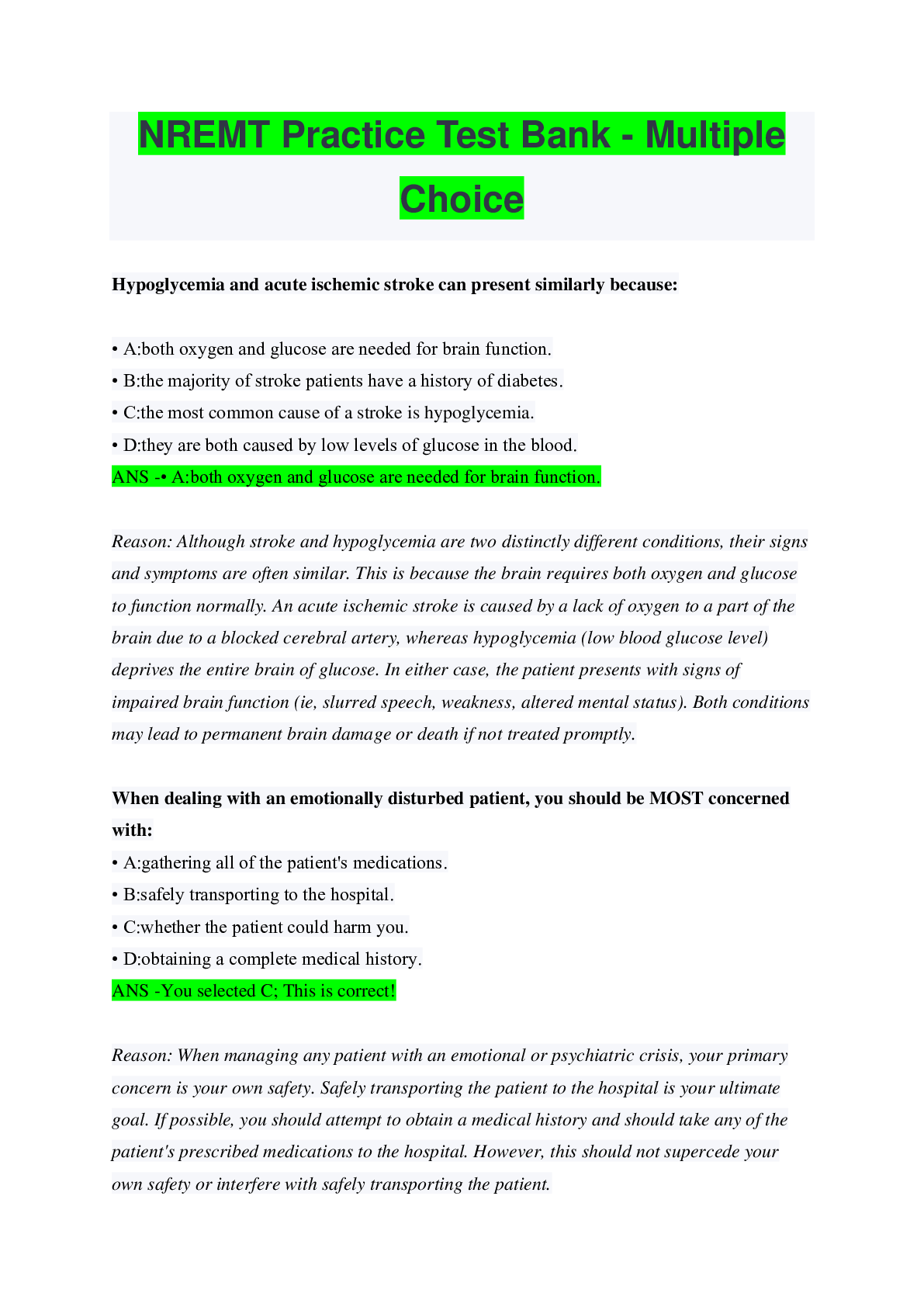
Also available in bundle (1)
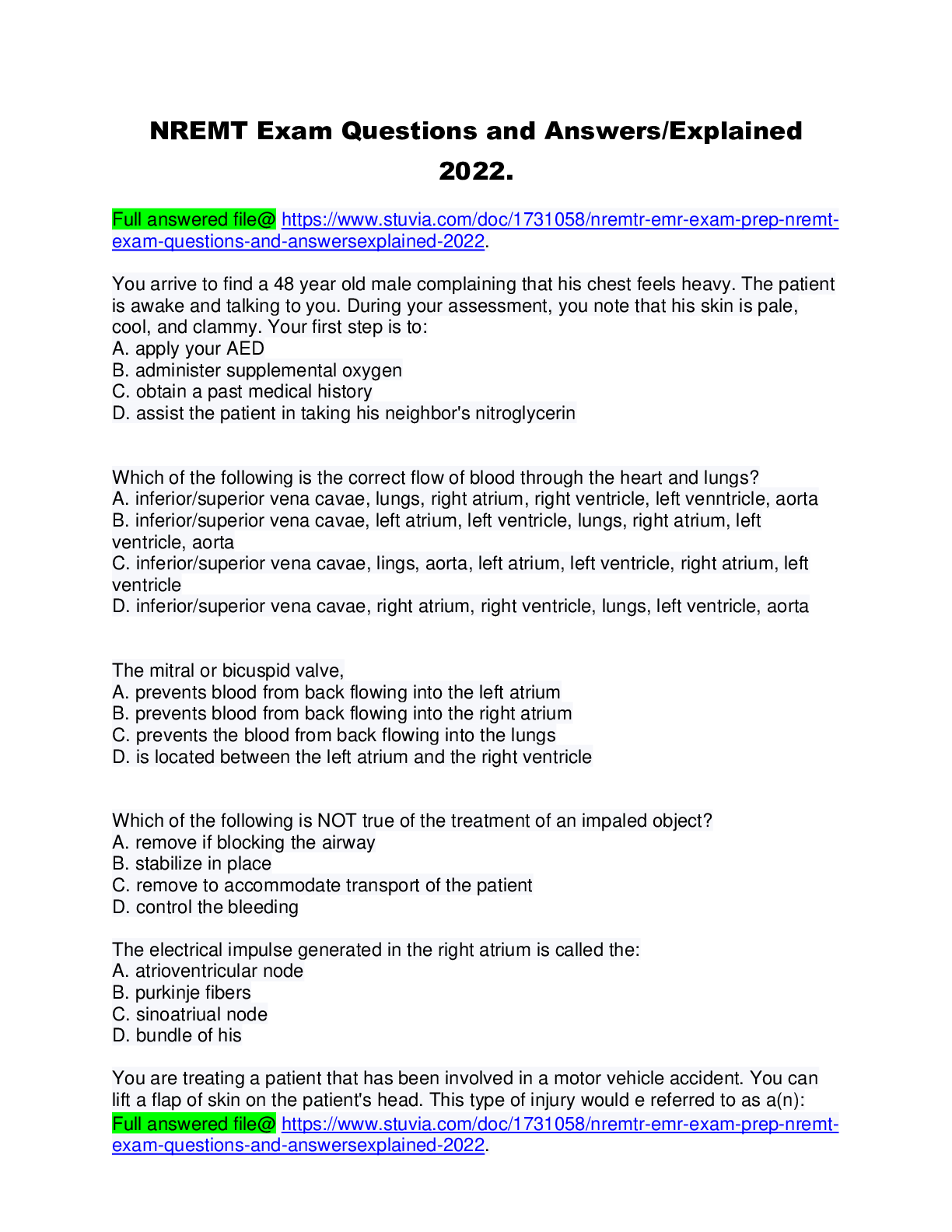
NREMT EXAM BUNDLE. QUESTIONS WITH ACCURATE ANSWERS, LATEST UPDDATES
COMPRISES OF ALL EXAMINABLE NREMT EXAM QUESTIONS WITH ACCURATE ANSWERS.
By bundleHub Solution guider 1 year ago
$32
25
Reviews( 0 )
Document information
Connected school, study & course
About the document
Uploaded On
Aug 12, 2022
Number of pages
219
Written in
Additional information
This document has been written for:
Uploaded
Aug 12, 2022
Downloads
0
Views
133




